



















































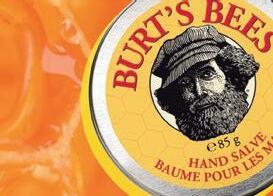











Advertising:
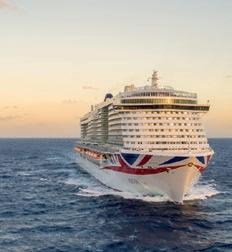
















Are you one of the hundreds of thousands of Irish people who spent time working in the UK from the 1970s onwards? XtraPension, a Galway-based company promises to help you claim your UK state pension.
Having filed over 4,500+ successful HM Revenue & Customs (HMRC) applications over the last decade, the XtraPension team is uniquely well placed to guide customers through the application process, compiling all relevant documents and submitting on their behalf. If an application is approved by HMRC, XtraPension then guides customers through the process of paying voluntary contributions to secure a UK pension currently worth up to €12,250 (£10,608) per annum and increasing annually - with no impact on their standard Irish State Pension.
Currently, Irish people who lived and worked in the UK for a minimum of 1+ years may be entitled to a UK state pension, thanks to an EU law from 2004 that applies post-Brexit. Not only that, but they can pay for voluntary contributions to fill gaps in their National Insurance Record and, in doing so, boost their pension.
Most people working in Ireland are able to pay approximately €200 per year directly to HMRC which buys them a UK pension worth over €5,000 in retirement for each year they chose to buy - assuming an average Irish lifespan. The more years people choose to buy, the bigger the UK pension they get.
Right now, Irish people can cheaply pay for past years from 2006 (or later if that’s when they left the UK) up until now, potentially buying as many as 18 years.
The scheme as it stands is currently being operated at the discretion of the UK Government and has been subject to high demand. Applicants have until April 2025 to pay voluntary contributions to make up for gaps between 2006 and 2016. After that deadline, applicants will only be able to buy back a maximum of six years.
For example, an Irish person who spent 9 years working in the UK could opt to pay for just 1 year at a once-off rate of approx. €200 and secure a minimum UK pension of €3,500 every year. Alternatively, they could buy up to 26 years’ worth for €5,200 to secure an annual UK pension of €12,250 every year once they turn 67.
For more information contact Xtrapension at 091 335583
Click&Go have released their 2024 ranking of top City Break destinations broken down by season. The list includes the very best value destinations for both winter and summer short getaways.
Prague was rated as the top winter city destination for couples with Rome being the top summer city destination for couples.
The top bank holiday destination for both couples and families is London closely followed by Berlin, Krakow, Lisbon and Rome.
Top five winter city destinations for couples in 2024
1. Prague – 3 nights from €199pp
2. Lisbon – 3 nights from €229pp
3. Rome – 3 nights from €259pp
4. London – 2 nights from €189pp
5. Budapest – 3 nights from €199pp
Top five summer city destinations for couples in 2024
1. Rome – 3 nights from €279pp.
2. London – 3 nights from €199pp.
3. Lisbon – 3 nights from €249pp.
4. Amsterdam – 2 nights from €249pp.
5. Barcelona – 3 nights from €279pp.

The Menopause Hub App, the first of its kind in this country, includes the latest information and research about the hormonal changes endured by women in their 40s and 50s.
They can also use the mobile app to monitor their own menopausal and perimenopausal symptoms and receive medication reminders. Launched by award-winning specialists, The Menopause Hub, the app is the brainchild of the clinic’s CEO and founder, Loretta Dignam. She opened her first clinic in 2019 after finding out for herself the lack of help available to menopausal and perimenopausal women – and said the data gathered by the app can be used by researchers investigating future treatments. ‘The aim is that the data collected will provide a valuable insight into the effectiveness of current therapies, such as HRT and/or cognitive behavioural therapies, and this knowledge can also be used by clinicians when prescribing treatments.
‘Combining the latest technology with up-to-date data about female health will not only improve outcomes for women today, but will also improve the range and impact of menopause treatments available to future generations,’ said Ms Dignam.
The app was developed by medical technology company Zendra Health, which is helping over 80 healthcare services and organisations across the US, UK and Ireland digitalise their care pathways.

This heart-thumping moment of pride, brought to you by a timely intervention from our 24/7 Urgent Cardiac Care service.
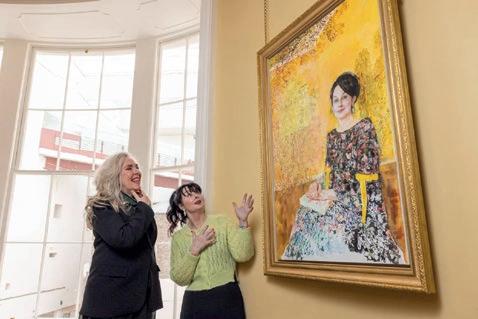
Marian Keyes is a multi-award winning author who has sold over 30 million books worldwide throughout her career. Born in Limerick and raised in Cork, Galway, and Dublin, she graduated from University College Dublin with a law degree, and moved to London in 1986. Her first novel, Watermelon, was published in 1995 and since then she has published 15 novels in a total of 37 languages. Her warmth and humour have earned her legions of fans across the world, and Keyes uses her light-hearted style to address issues such as addiction and domestic violence, bringing them into popular conversation. She also speaks frankly on her own struggles with addiction and depression.
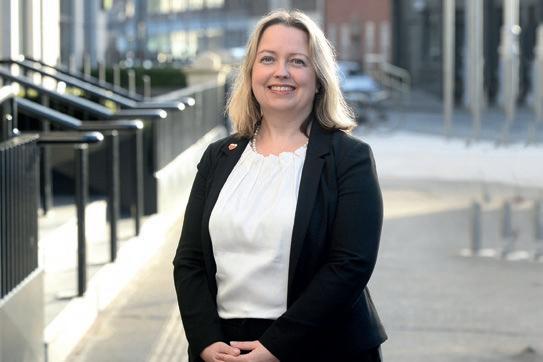
Ireland (HPAI), told the Dáil’s health committee.
Over the past 29 years, Marian Keyes has won an array of awards for her work including the 2021 Irish Book Awards and 2022 British Book Awards author of the year. In addition to her novels, Keyes has also published collections of journalism, and has in recent years moved into broadcasting, releasing a podcast Now You're Asking with Marian Keyes and Tara Flynn with BBC Sounds and BBC Radio 4. In 2019, she was awarded an honorary doctorate from the University of Limerick. She currently resides in Dun Laoghaire, Dublin.
Dublin-born Margaret Corcoran studied Fine Art at the National College of Art and Design and the Chelsea School of Art in London. Often intricate and richly-coloured, her work reflects her broad range of interests, from social and art history to colonialism, post-colonialism, and mythology. She has been inspired by a rich range of sources, from art and feminist theories, to the history of political thought. Her work has been displayed in solo and group shows in Ireland and abroad, and features in several prestigious public collections, such as the Office of Public Works and the Arts Council of Ireland.
Dr Caroline Campbell, Director of the National Gallery of Ireland, commented, ‘It is a great honour to unveil this portrait of Marian Keyes today. Marian’s books mean so much to so many across the island of Ireland and beyond. To have her represented in the National Gallery of Ireland is very exciting. The origins of our national portrait collection date back to 1875. It is regularly being enhanced by commissioned portraits of prominent figures from contemporary Irish life and is a source of joy and fascination for our Irish and international visitors. We know that this new work by Irish artist Margaret Corcoran will be a draw for our audiences young and old.’
It also pointed to recent research showing that just four industries - tobacco, unhealthy foods, fossil fuels and alcoholare responsible for at least a third of deaths globally per year. Among the measures it is calling for is a curb on junk food adverts targeting children. The umbrella group was represented by Janis Morrissey, the Director of Health Promotion, Irish Heart Foundation, Dr Sheila Gilheany, CEO, Alcohol Action Ireland, and Dr Liz O'Sullivan, Lecturer in Nutrition, TU Dublin. Too much focus is placed on awareness campaigns and slogans such as ‘drink responsibly’ to encourage individuals to adopt healthier lifestyles, Ms Morrissey said. But with figures showing the alcohol industry in Ireland spent €116 million on advertising in 2021, such campaigns are “simply not enough”.
The HPAI argues that the population in Norway – where there is a complete ban on alcohol advertising - drinks 37% less alcohol compared with Ireland. On this basis, the Alliance insists one of the solutions to growing waiting lists and trolley queues is ‘staring our legislators in the face’.
The HPAI – established last year to advocate for major policy change to promote the primary prevention of chronic disease – also called for a review of the Healthy Ireland strategy, due to end in 2025, so that future policies address the structural drivers of chronic disease.
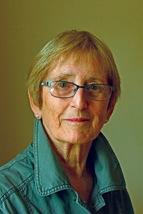
The crossword in this issue of Senior Times is the last compiled for the magazine by Zoe Devlin after more than 20 years.
We send our sincere thanks to Zoe for her hugely popular crossword. In the meantime Zoe will be concentrating on her writing. She has written two bestselling books on Irish wild flowers.
Interest rates offered on fixed term and demand deposits have become increasingly attractive over the past 12 months but are you getting the most bang for your buck? It‘s possible to secure a higher interest rate for your savings by looking beyond traditional savings institutions in Ireland. Irish savers in search of better rates have been investing in savings products offered by banks operating across the EU –Ireland, Spain, the Netherlands, France, and Germany are among the fastest-growing markets for savings deposits in Europe as savers look to maximise the return offered to them for cash deposits in a simple and hassle free way.
While it is certainly good news that the rate of inflation is decreasing, it may prompt the European Central Bank (ECB) to consider lowering interest rates. While experts have predicted a rate cut in June, it could happen as early as April. Since September last year, the European Central Bank has maintained its key interest rate at record highs of 4.5%. The first decision of the year has also maintained the policy stance without hinting at when rate cuts will happen. Therefore, taking advantage of higher savings rates now is essential while you still can.
Analysis shows that an individual saver in Ireland with €50,000 could miss out on interest earnings up to €500 per year by not exploring alternative savings options available from European banks.
So, what can savers do to safeguard their hard-earned money?
Raisin Bank offers an alternative to traditional banking options for Irish savers. Raisin is an online marketplace for savings accounts across Europe. Once registered, customers can easily access a range of offers from banks from countries such as Portugal, France and even Sweden to name but a few –

Raisin collaborates with around 400 banks and financial service providers from over 30 countries.
With a single sign up to Raisin, you can benefit from interest rates up to 3.50% AER* and access some of the best rates on fixed-term and demand deposit savings accounts from banks across Europe. Additionally, you can fund and manage multiple savings accounts with your free account, thereby maximising your deposit guarantee coverage. There are no hidden fees and no hassle.
Signing up with Raisin Bank is a straightforward process requiring only a single online registration. Once registered, customers can choose from various savings accounts offered by other European banks and manage them online.
Here are the steps to get started:
• Open a Raisin Account by registering on Raisin.ie
• Receive your login information & complete your secure video identification
• Sign up for savings account(s) and manage them all online
After Raisin Bank verifies your identity and sends you your login details, you can access exclusive offers from partner banks across Europe. You can manage your various deposit accounts, stay up-to-date about new savings
products, and transact through the platform.
In most cases, your returns will be paid out tax-free. However, you‘ll need to declare any returns for Deposit Interest Retention Tax (DIRT) on your annual tax return in Ireland, which is currently at 33%.
Any money you have on deposit up to €100,000 per bank is covered by the relevant Deposit Guarantee Scheme of the country where the bank operates. You can compare the country ratings quickly and easily on the Raisin website and decide which savings accounts are best for you and your savings goals.
Grow your savings today – visit www.raisin.ie/st/ *rates & comparison correct as of 28th February 2024

Robert De Niro went to Sicily to familiarize himself with the language, bringing a tape recorder with him to Palermo. He learned it in record time. Only three of his lines in the film are in English, one being the famous, ‘I’ll make him an offer he can’t refuse.’

Its 50 years since the release of Godfather Part Two, a film that many critics believed surpassed the original. Aubrey Malone recounts its journey to the screen


It’s hard to believe Francis Ford Coppola’s The Godfather Part II is half a century old this year. Still harder to believe is that it was such a wonderful film. Sequels (The French Connection II apart) aren’t generally noted for living up to their predecessors. In this case the task was even more herculean considering the hoo-ha that surrounded the first Godfather.
This signalled Marlon Brando’s renaissance after a decade in the wilderness. He’d been labelled ‘box office poison’ as a result of that decade. Robert Evans, the head honcho at Paramount, insisted he subject himself to the relative ignominy of a screen test before he considered him for the role of Vito Corleone.
Brando was hard up for cash at the time so he took a waiver on a percentage deal for the movie. In retrospect this was foolish. Earnings from it could have set him up for life financially as it was such a hit but he needed hard cash at the time so took the money upfront.
When it came to The Godfather Part II, Coppola asked him if he would appear
in it briefly. He also wanted to use some footage of him from the 1972 film in a flashback sequence. Brando, however, was still licking his wounds from losing out on a windfall from that film and demanded an astronomical sum from Coppola to use him: $500,000 of a salary and 10per cent of the gross. There was no way Coppola could afford that kind of money so the idea was scrapped.
If the 1972 movie saw the rebirth of Brando, Godfather II was mainly notable for the arrival of the actor sometimes referred to as his spiritual ‘godson,’ no pun intended, onto our screens. This was Robert De Niro, who plays Vito Corleone as a young man. De Niro was a relatively unknown quantity in 1974. It was many people’s first time seeing him act. De Niro had actually auditioned for the part of Sonny Corleone in the original but was unsuccessful. It went to James Caan instead. The fact that Coppola had recently seen him give a sensational performance in Martin Scorsese’s cult movie Mean Streets sealed the deal for him.
De Niro went to Sicily to familiarize himself with the language, bringing a
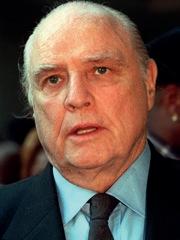
Brando was the big loser on the night by throwing away the chance to be a part of it all. He would have been 100 on April 3 of this year. Let’s spare a thought for the great man who has, as the Don himself might have put it, been ‘sleeping with the fishes’ since 2004.
tape recorder with him to Palermo. He learned it in record time. Only three of his lines in the film are in English, one being the famous, ‘I’ll make him an offer he can’t refuse.’


Spring is the perfect time for your short break in Northern Ireland. There’s always great value on offer and an endless list of things to do, see, eat, drink and experience at every turn, with few places boasting as many options as the Causeway Coastal Route. Start planning your trip today!

Carrickfergus Castle
An imposing 800-year-old Norman castle built right on the northern shores of Belfast Lough that has been immaculately preserved down through the ages.
Giant’s Causeway & Carricka-Rede Rope Bridge
A
rope bridge that
a dramatic drop to the Atlantic Ocean and connects Carrick-A-Rede Island with the mainland.
The Gobbins, Islandmagee
A marvel of engineering when it first opened in 1902, The Gobbins Cliff Path was reimagined in 2015 as a spectacular walkway along the rugged and sheer face of the Antrim cliffs.
Dunluce Castle & Magheracross Viewing Point, Bushmills
The spectacular ruins of a majestic medieval castle, first built here in the 1500s by the MacQuillan family and added to over the centuries.
Rathlin Island
A small, fascinating island six miles from the coast with a little over 140 inhabitants living side by side with extraordinary wildlife.
Mussenden Temple, Castlerock
Built in 1785, Mussenden Temple was designed in a flamboyant Italian style as a summer library and forms part of the extensive Downhill Demesne.
Continue your giant adventure at more must-sees like Old Bushmills Distillery, The Glens of Antrim, Slemish Mountain, Blackhead Coastal Path and Causeway Coast Foodie Tours. Scan here for your full guide to the Causeway Coastal Route.


* * The Bushmills Inn, Bushmills
Fullerton Arms, Ballycastle

The Causeway Coastal Route is known world over for its natural beauty, but equally as appealing are the incredible culinary experiences on offer.
• Fidela Coffee Roasters, Coleraine
• Lir, Coleraine
• Harry’s Shack Restaurant, Portstewart
• Ice cream at Rinkha,Islandmagee
• The Light House Bistro, Whitehead
During your visit you’ll need somewhere to stay, and there’s no shortage of great value offers on world-class accommodation. From somewhere cosy just to lay the head at night to something a little more sophisticated, the choice is yours!

The young Vito is a kind of Robin Hood figure who shoots a thug operating a protection racket in a seminal scene. (I can still see that dim light blinking). He portrayed Vito as a man who watches everything like a lion in the long grass, behaving in an almost courtly manner to people he meets and greets. His steel side only comes out when he kills.
Accepting the fact that he didn’t look in the least like Brando, De Niro concentrated instead on copying his gestures, like touching his cheek with his fingertips the way Brando did, and adopting the same rasping tone of voice. It seems almost every stand-up comedian in the world has imitated this rasp at some point. In the novel, Don Corleone is described as having been shot in the throat at one point. It was this detail Brando picked up on, stuffing Kleenex in his cheeks to achieve it for his screen test. De Niro was reputed to have watched the 1972 movie over fifty times to try and ‘get’ Brando.
Attention now shifted to whether Al Pacino would again play Michael Corleone, Vito’s son, as he had in 1972. Coppola had to fight hard to get ‘the suits’ to agree to cast Pacino (another unknown quantity at the time) in the original film. In the first few scenes they thought his performance was lacklustre. At one point they were considering getting rid of him.

Brando really liked Pacino and said, ‘If he walks, I walk,’ so they kept him on.
Pacino had made two great movies afterwards, the offbeat Scarecrow with Gene Hackman (he once said this was his favourite of all his movies) and Serpico, for which he’d been Oscar-nominated. The double whammy of screen gems made Coppola’s decision to re-employ him for the part of Michael much easier.
In the end it was Pacino who vacillated. He didn’t like the idea of being in a sequel so early on in his career for fear it would limit him but Coppola won him over with his enthusiasm for the project, conveying so much excitement for it that the hairs actually stood up on Pacino’s head. Pacino had received just $35,000 for the 1972 movie. For The Godfather Part II he earned $600,000 plus 10% of the gross.
In the original he was somewhat awed by Brando. This was appropriate as at that age Michael was just a young man finding his way in the ‘family business.’
In the second film he’s a few years older and also a few years more corrupt – and he doesn’t have Brando breathing down his neck. At times Michael reminds one of a Roman emperor, a sad despot losing everyone around him as his lust for power takes him over.
This was an emphasis Coppola wanted. So did Puzo, who collaborated with him on the screenplay. Coppola used Puzo’s scenes from Little Italy from his novel but added a narrative skein that included the Corleone family’s involvement in Latin America, taking in the fall of the Cuban dictator Fulgencio Batista and the arrival of Fidel Castro in Havana in 1959.















Some critics of the original movie accused Coppola of glorifying the Mafia in it, portraying them almost like other iconic American dynasties like the Kennedys and the Rothchilds, even though at the end of the film we see Michael lying to his wife and closing the door on her. Coppola was anxious to make his callousness more patent in the sequel. In The Godfather Part II we’re in little doubt that this family is more akin to the Borgias than the Kennedys. ‘I had bounce in the first Godfather,’ Pacino said, ‘In the second one the bounce has gone. There’s only the badness. That gave me a different kind of challenge.’ Such badness results in him even ordering the killing of his brother Fredo in one scene.
Diane Keaton played his wife again. She admitted she was only ‘background music’ in the 1972 movie. In the sequel she has much more to do and does it brilliantly.
Another interesting casting choice was Lee Strasberg as the Jewish mobster Hyman Roth. Strasberg was the legendary director of the Actors Studio. Both De Niro and Pacino had studied at this, and indeed Brando for a time. Strasberg had never stepped in front of a camera before The Godfather Part II but Coppola was still terrified of directing him. How could he direct the ‘godfather’ of The Method? He was as nervous about the task as he had been directing Brando, another living legend, three years before but in the end he found the task entirely pleasurable.
Coppola deserved great credit for threading the movie together. Right from the get-go he decided it was going to be a different kind of sequel to the kind audiences were usually proferred. This was even conveyed by the title. Calling the film The Godfather Part II instead of Godfather II was unusual. Once again, the ‘suits’ didn’t like this, imagining viewers would see it as the second half of a movie rather than a complete unit, but Coppola got his way. He also got his way in the diametric manner in which the film was structured, mixing Michael’s fall from grace with the rise of the young Vito in another country.
‘You’re making two separate movies,’ he was told at one point, ‘Get rid of one of them.’ But Coppola stood his ground and it reaped dividends. Lighting genius Gordon Willis contrasted the hazy mistiness of the flashback sequences with the sharpness of the contemporary ones to convey the manner in which the family’s world had changed in the interim.
The film took nine months to shoot and came in at a budget of $13 million, $2 million more than was estimated, but by the end of 1975 it had earned over $30 million in America alone. It also won six Oscars, three of these going to Coppola, for Best Director, Best Film and Best Original Screenplay. Another Coppola, Francis’ father Carmine, was a co-winner of the Best Musical Score Oscar so it was a real family night. The film also won Best Art Direction and a Best Supporting Actor Oscar for De Niro. In typical
Garboesque fashion he didn’t attend the ceremonies. Coppola collected it for him. Disparaging to the last, he afterwards remarked, ‘Lots of people win the award who don’t deserve it but I suppose it’s not
It was only the second time in movie history that an Oscar was awarded for a subtitled part, the other being the one given to Sophia Loren for Two Women in 1960. This was also one of the few times in Oscar history where two Oscars were conferred on the same character. (Brando famously refused his one for playing Don Corleone in 1971.) Both Heath Ledger and Joaquin Phoenix both won Oscars for playing The Joker in different Batman movies some years down the road.
Trivia buffs among you might also like to know that Paul Newman was nominated for an Oscar playing the pool shark Eddie The Hustler in 1961 and won one 25 years later for playing Felson as an older man in Martin Scorsese’s The Colour of Money
Brando was the big loser on the night by throwing away the chance to be a part of it all. He would have been 100 on April 3 of this year. Let’s spare a thought for the great man who has, as the Don himself might have put it, been ‘sleeping with the fishes’ since 2004.
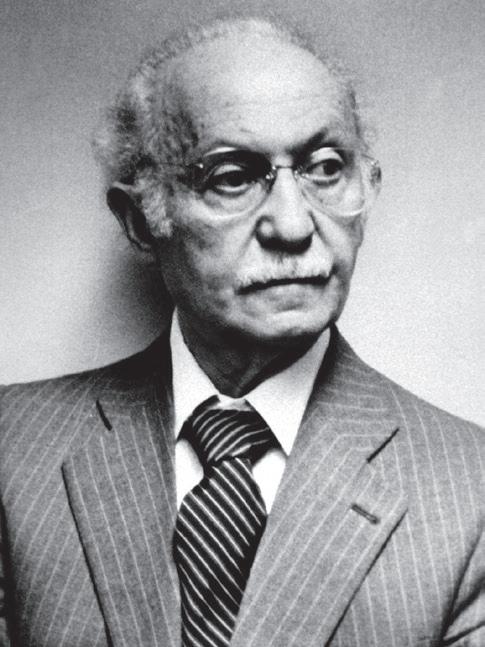 Diane Keaton played Al Pacino’s wife again. She admitted she was only ‘background music’ in the 1972 movie. In the sequel she has much more to do and does it brilliantly.
Diane Keaton played Al Pacino’s wife again. She admitted she was only ‘background music’ in the 1972 movie. In the sequel she has much more to do and does it brilliantly.
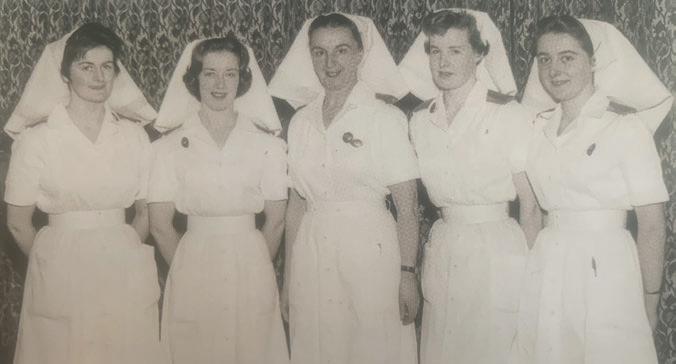







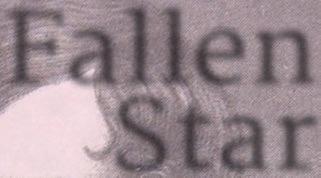

Irish readers of a certain age may recall the ‘New Senior Prose’ anthology (published in 1955) that was one of their texts for their school Leaving Certificate English Examination. Out of the selection of twenty-two English Prose masters, only two were Irish. One was Oliver Goldsmith, who spent most of his life in England; the other was the Irish patriot and journalist John Mitchel (1816-1875). His Bermuda was a fine example of the literary skills that made him such a thorn in the side of the British administration in Ireland.
Bermuda is an extract from Mitchel’s famous Jail Journal. It is based on notes he made in 1848 while aboard a prison ship anchored off one of Bermuda’s islands on his way to a penal colony. (Ironically, the island was named ‘Ireland Island’). Although the piece is an integral part of his Journal, it is also a stand-alone example of masterful writing.
Convicted for his advocacy of resistance to the cruelties of the Irish landlord system and the continual shipment of grain to England during the famine years of the 1840s, Mitchel had been sentenced to 14 years transportation. By the time of his trial, his fame at home and abroad as an agitator for Irish independence had made him a dangerous man in the eyes of the British authorities. As one of the principal contributors to The United Irishman, the newspaper of the Young Ireland independence movement, his trenchant political views and felicitous literary style ensured that the paper had gained wide circulation.
Augmenting British difficulties in dealing with him was the uncomfortable fact that Mitchel was an educated Protestant lawyer (and the son of a Unitarian minister). He knew the British legal system inside-out and the government therefore made sure to pack the jury
Eamonn Lynskey recalls the controversial career of one of Ireland’s greatest patriots.
with persons who would definitely convict him, no matter what defence he put forward. So it was that in June 1848, he found himself aboard a prison ship anchored off the coast of Bermuda, bound for Van Diemen’s Land (now Tasmania). His Jail Journal is the extraordinary account of that voyage as a prisoner and of his subsequent escape to America.
Some men cram several lives into one lifetime and John Mitchel was such a man. From being one of the foremost activists for Irish independence in his native Ireland, he would become one of the most forceful agitators for her cause in the United States. The years of Irish agitation; the drama of his trial and conviction; his privations aboard prison ships (where he suffered badly from asthma); his confinement in Van Diemen’s Land and his eventual escape to America – all these adventures could well be the stuff of an exciting novel, or even several novels.





























The welcome he received in San Francisco on October 9, 1853 was extraordinary. Even more so his arrival in New York some weeks later. Music bands, civic and benevolent societies, various Irish-American organisations and multitudes of well-wishers all turned out to welcome the man they most identified with the then current chapter in Ireland’s long fight to overthrow colonial oppression. His incarceration, and the shameful way it was attained, had been constantly in the minds of IrishAmericans ever since his trial. To see him standing free among them was, in itself, a triumph against British injustice.
So it was that he entered a new life in the New World: that of the embodiment of the hopes of the millions of IrishAmericans who had not forgotten the black years of famine and forced emigration. The excitement occasioned by his arrival continued for several weeks with meetings, addresses and banquets, causing Mitchel – never a man overgiven to humility – to write in his Journal ‘what in the world can I do for all these good folks, I asked myself, in return for so much generous kindness?’. It was indeed a truly wonderful reception but the universal adulation was not to last for long.
Mitchel immediately set about trying to organise the groups dedicated to achieving Ireland’s independence. And almost immediately he found that these groups were often inimical to each other.
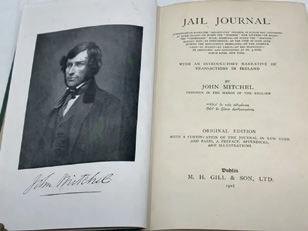

As well as this, as a Protestant patriot in the long tradition of Protestant patriots stretching back to Theobald Wolfe Tone, Mitchel’s vision was Tone’s vision: a State in which the views of Catholic, Protestant and Dissenter would have equal parity. And while this was accepted generally by Irish Catholic Americans, it was a view not strongly favoured by the Irish-American Roman Catholic hierarchy which had in mind an Irish independence more orientated towards the Catholic Church. Mitchel took issue with the influence of its clergy on the various movements for Irish freedom and this led to serious differences between him and the American Catholic hierarchy, most notably in a highly public row with his fellow Ulsterman, John Hughes, the Archbishop of New York.
He also took issue with the followers of Daniel O’Connell, ‘The Liberator,’ whose achievement of Catholic Emancipation in 1829 had ensured his place among the leaders of Irish political affairs at home and abroad. The overwhelming Catholic composition of O’Connell’s following seemed to Mitchel exclusive of other persuasions. Achievement of a confessional State in which the Roman Catholic Church would determine laws and mores was not Mitchel’s idea of freedom. This led to his underestimation of the power of the Church in IrishAmerican affairs and the respect in which figures such as Hughes and O ‘Connell were held. Like all singleminded men with a fixed idea, he did
not pay enough attention to what is now called ‘grass-roots’ politics. The fact that Irish-American Catholics would always be loath to go against the views of their churchmen seemed to escape him. So it was that, only a few years after his arrival, his disagreements with important Catholic Church figures and with the various factions within the independence movement meant that his influence and popularity began to wane. It declined further when his hostility to the Abolitionist cause became known.
In Mitchel’s view, involvement in abolitionist politics was a distraction from the cause which he considered should have been central to every Irish-American: the freedom of Ireland. However, his objections to abolition went deeper. Mitchel was pro-slavery, and many of his admirers, then and now, have puzzled over this apparently glaring contradiction within one so dedicated to freedom. But Mitchel’s idea of freedom was based on the mores of classical Greece and Rome, ancient societies which were seen by him, and by western society generally, as exemplars of enlightened civilisation. It was (and is) sometimes forgotten that these admired societies were founded on slavery and that the triremes that ruled the Mediterranean were powered by galley slaves, captives who were worked to death. In Mitchel’s view, enslaved peoples were as necessary an underpinning of society in 19th century America as they had been in ancient times.










While he himself never owned slaves, he must have been aware of the wretchedness and inhumanity of slavery. Yet he persisted in his view that these captives were better off as slaves in America than they would have been if free in their own homelands; and that under the rule of Western society they would come to be civilised. He did not seem to see the similarity between this paternalistic view towards ‘inferior peoples’ and the attitude of the British colonial regime in Ireland towards the Irish. In 1847 in Ireland, he had travelled to the western county of Galway and had witnessed at first-hand the devastation and misery of famine, exacerbated by British indifference or (as Mitchel believed) by British wilful engineering of the famine’s effects. This experience had hardened his hatred of colonial administration and it is possible that, had he spent a similar period examining in detail the conditions of the unfortunate enslaved peoples in the New World, he might have come to change his mind. In any case, it was his pro-slavery attitude, along with his hostile statements towards the Catholic Church, that gradually undermined his status in North America as an unrivalled icon of Irish agitation for freedom.
In parallel with this lessening of political stature was his own growing disenchantment with the society of the northern states of the United States. He was uncomfortable with the onrush of industrial enterprise and the frenetic pursuit of monetary gain which he saw around him in New York and elsewhere. As mentioned, his star had also waned considerably in the North because of his unpopular pro-slavery views and his support for the secessionist cause of the
southern states further damaged his reputation. He decided to move to Tennessee in 1855, believing that the southern states had a lifestyle nearer to his own romantic notions of a rural idyll where the pace of life was slower and its quality higher than that of the North.
His move south coincided with the quickening of events which would lead to the outbreak of the American Civil War.
In The Southern Citizen, a newspaper he founded in 1857, he wrote that the southern states, in defence their freedom and way of life (including slave-owning), had as much a right to leave the rest of the ‘United States’ as Ireland had a right to leave the ‘United Kingdom’; and he devoted his considerable literary skills to championing their cause. It may temper some of the condemnation of his views to learn that he lost two sons fighting on the Confederate side in the eventual civil war.
After the war he was jailed by the Union authorities because, as editor of the New York Daily News, he continued to defend the right of the southern states to secede. The jailing did not last long but was under severe conditions and affected his health. After some more years of largely futile involvement in Irish-American affairs, he returned to Ireland in 1874 where he was welcomed as a hero by his countrymen who had not forgotten his sacrifices in pursuit of Irish freedom. He risked arrest as an escaped felon but the authorities, considering his stature among the restless natives, chose to do nothing. However, when he contested a parliamentary seat in Tipperary and was elected unopposed (despite having spent the previous twenty-six years away from Ireland and not having canvassed a single vote), he was declared ineligible to take
his seat. And when the election was held again, and he was elected again, he was again disqualified.
John Mitchel died 20 March 1875 at the age of 59, shortly after he heard the news of his second election success. In the last letter he wrote, he thanked the voters of Tipperary for supporting him in exposing the 'fraudulent' system of Irish representation in the English Parliament. Without doubt, he took a grim satisfaction in showing how the British could ignore, when convenient, the wishes of their Irish subjects.
John Mitchel’s faults are impossible to overlook, especially his strident proslavery views. Always the most execrable of practices visited on one section of humanity by another, any justification of its existence must be regarded as seriously lacking in even the most basic understanding of how evil it is. As well as this, Mitchel’s espousal of physical force nationalism does not sit easily within the present-day reconciliatory currents of Irish politics. However, all that being said, his dedication to Irish freedom and his inspiration to Irishmen and women in their pursuit of that freedom cannot be doubted. As Arthur Griffith wrote in his preface to Mitchel’s Jail Journal in 1913: ‘When the Irish Nation needs explanation or apology for John Mitchel the Irish nation will need its shroud’.
Already there have been calls for his statue in the centre of Newry to be removed. But is not some respect due to a man who devoted his life unselfishly to Ireland’s cause, whatever his personal failings? March 2025 will see the 150th anniversary of John Mitchel’s death. Will Ireland be able to set aside his undoubted faults and commemorate in some measure his steadfast dedication to Irish freedom?



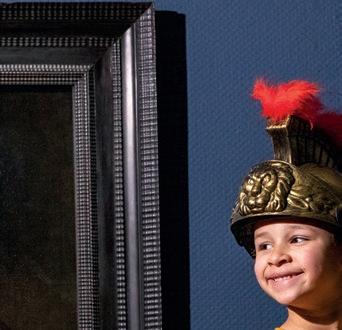
Double page spread. Some of the images are a bit flat, can you lighten them up a bit.
Central Park, New York
El Espanda, Spain
Evening Tangiers
A garden in France

Loch Katrine, Scotland
On the cliffs


Art
The National Gallery of Ireland has just opened its latest ground-breaking exhibition – Turning Heads: Rubens, Rembrandt and Vermeer – which will run to the public until Sunday, 26 May 2024. Featuring works by Dutch and Flemish artists of the sixteenth and seventeenth centuries, the show explores tronies – intriguing paintings of heads. The exhibition is a collaboration between the Royal Museum of Fine Arts Antwerp and the National Gallery of Ireland.
Turning Heads offers the visitor a rare experience to embark on a captivating journey through time as each painting introduces a character from centuries past. Discover hidden historical contexts that breathe life into intriguing artworks from the sixteenth and seventeenth centuries. The exhibition allows the public the extraordinary experience of getting acquainted with diverse personalities of the past that are easy to appreciate and enjoyable for everyone.
The exhibition features artists’ portrayals of the human face, its morphology, expression, and lighting around it. Known as ‘tronies’, a rare term in common parlance, these works refer to small and playful paintings of heads which became very popular in the early seventeenth century. Turning Heads traces the emergence of this historical art phenomenon from the sixteenth century to its heyday through the work of iconic artists such as Peter Paul Rubens, Rembrandt van Rijn, and Johannes Vermeer.
Highlights of the exhibition include Vermeer’s Girl with the Red Hat, c. 1669, the artist’s smallest recorded painting. The work is filled with beautiful colourful details, and a highly sensitive use of light that reflects his fascination with optics. Rembrandt’s


National Gallery of Ireland launches exhibition celebrating the works of John Lavery
The highlight of the National Gallery of Ireland’s autumn-winter programme Lavery On Location, which recently opened and will run to 14 January This is the first major monographic exhibition devoted to this modern Irish in three decades This new ‘must-visit’ exhibition includes more than 70 paintings from public and private collections, features a number of never-before works, and has been made possible with the support of Arthur Cox
The Laughing Man, c. 1629-1630 is an example of how artists studied their own faces to apprehend its morphology and diverse expressions. Here, Rembrandt’s likeness can be seen in the grinning character of his painting. Rubens worked with a variety of models to study their features from different angles and with great observation. The elderly sitter featured in his Study of an Old Woman Seen from the Front, c. 1617 appears in a number of head studies by both Rubens and Jacob Jordaens. Finally, The Man with the Golden Helmet from the Circle of Rembrandt is as much a study of the lustre of a striking golden helmet as the psychology of the brooding sitter. Artists in the Netherlands were particularly interested in dressing up their tronies in various costumes, which is explored in detail in Turning Heads. Other artists featured in the exhibition include Anthony van Dyck, Jacob Jordaens, Michael Sweerts, and Adriaen Brouwer.
Friends of the National Gallery of Ireland receive free unlimited entry to all exhibitions. Tickets are also free for children (18 and under), international protection applicants, refugees and carers. There is free entry for all to the exhibition on Wednesday mornings and tickets are €5 on Thursday evenings.
Exhibition information:
• Turning Heads: Rubens, Rembrandt and Vermeer
• Beit Wing, National Gallery of Ireland
• Open now until 26 May 2024.
• Curators: Dr Lizzie Marx & Dr Brendan Rooney
• Tickets from €5
• This exhibition is a collaboration between the Royal Museum of Fine Arts Antwerp and the National Gallery of Ireland.














If you’ve got a Free Travel Pass, be sure to use it on the Expressway network. A registered Carer or Companion can travel with you - and you can book seating for just €2 on Expressway.ie




In the latest of her literary-themed journeys Lorna Hogg visits Dorset, the setting for most of Hardy’s books


We all like to see the landscapes and surroundings that inspired our favourite authors - ideally, in their original condition. When it comes to nineteenth century authors, however, that can be a tall order. The passage of time, industry, new builds – all can cut through any inspirational countryside and buildings. However, the county of Dorset, in the south of England, has managed to maintain its original countryside and atmosphere. This has been helped by the fact that its many literary sites and ‘ hotspots’ have produced tourism interest – and protection, on their own, especially those connected to the Dorset literary giant - Thomas Hardy
Hardy has remained one of the most popular Victorian authors thanks in part to the films and TV series of his works. Just as important, however, is the fact that Hardy countryside still remains largely in its original form, which in itself is a tourist attraction. Thanks to good public transport links, and help from the well informed and friendly Dorchester Tourism Office, (the wise contact them
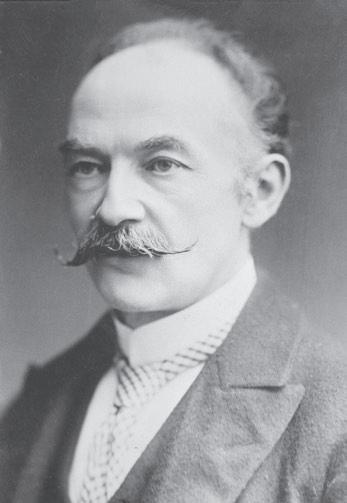
well before travel!) visitors have a wide range of choices, and the world of Thomas Hardy remains easily accessible to his readers.
He was born on 2nd June 1840 to a stone mason and his wife, and was soon joined
by a brother. Hardy’s novels often deal with social and class struggles - but it is also his timeless skill at characterisation that continues to draw readers and film goers. His early education came from his mother – he was eight years old when he started school, and well aware of the firm social divisions in that era. His family could not afford university for him – his father was a master builder stone mason, and the young boy helped with architectural drawing. After his schooldays, and then technical college, Hardy became apprenticed to an architect. He also attended evening classes at King’s College, during a London stay, and became a prize winner from the Royal Institute of British Architects.
In his era, Dorset was regarded as somewhat of a backwater, and an area in decline. Now, ironically, it is sought after, for its protected and appreciated countryside – showing that one man’s decline is another man’s unspoilt site of interest. The brooding moors, ancient forests, prehistoric sites, `chocolate box’ thatched houses, pretty villages and picture postcard coastal views now attract











BioXtra products help ease the symptoms and effects of dry mouth


visitors, helped by excellent bus and train links.
The young Hardy married Emma Gifford in 1874. He by then knew that he wanted to write. Some of his early works were published serially or commissioned, but his first successful book, encouraged by Emma was Far from the Madding Crowd. It proved popular and sold well, drawing on the surroundings that he knew. It also allowed him to design his own first house, at Max Gate, built by his father and brother, also near to Dorchester, and Hardy and Emma moved in during 1885.


The success of that first book allowed him to consider a career in writing. By this stage he could have been called a Liberal Free-Thinker – and this also affected his writings. Social deprivation, restriction, and limited opportunities were regular themes. He wrote about the countryside which he knew well, often changing local names. Weatherbury became Puddletown, and county town Dorchester morphed into Casterbridge. Surroundings also subtly mirror the feelings and situations of Hardy’s characters. The swordplay of Sergeant Troy, to impress and win over Bathsheba, and possibly seduce her (and possibly her wealth) into marriage, took place at the ancient and striking site of earlier conquest - Maiden Castle. Talbothays
beautiful surroundings and against idyllic summer – in complete contrast with her winter spell of ice and cold at Flintcombe Ash, picking vegetables with her bare hands. Alec D’Urberville literally leads her astray into an ancient primeval forest, home to centuries of hunters and the hunted, at Cranborne Chase. Finally, of course, she sleeps her last night of freedom on the altar at Stonehengewatched over by Angel St. Clare.
Hardy’s success with A Pair of Blue Eyes, is said to be based on his courtship of his wife. However, in his case, reality did not match romance. Hardy and his wife enjoyed initial happiness - but later lived estranged lives at Max Gate. However, The Mayor of Casterbridge proved another major success. The idea of a man selling his wife at a Fair was startling to many readers – although it could and did happen in Victorian times. However, when that man becomes a Mayor in later life, slowly and inexorably - rough justice, or the working of fate, is eventually done. These days, readers can still stand at the window at the Royal Hotel in Dorchester,
where Mayor Michael Henchard sees his world crumble. Irish actor Ciaran Hinds also won acclaim for his portrayal of Henchard.
Tess of the D’Urbervilles introduced another challenging topic to Victorian readers. subtitled `The Story of a Pure Woman’, its heroine, Tess was then, of course, seen as a `fallen woman.’ She was duped by a traditional wicked seducer and villain, Alec D’Urberville, who literally leads her astray – into an ancient forest known for centuries of hunting. Hardy, however, followed the Victorian code about the Wages of Sin, and after killing her seducer, Tess has a brief few days of happiness. Her arrest, whilst lying on the altar stone at Stonehenge, was followed by imprisonment and hanging.
After the death of his first wife, Hardy married his secretary, Florence Dugdale, in 1914. His writing success was both literary and financial, and won him acclaim. He could not have known, however, that later generations would



Enjoy a refreshing stroll on the East Pier and take in the breathtaking views of Dublin Bay from the perfect base in the luxury 4 Star Royal Marine Hotel in Dún Laoghaire
from
Escape to Ireland’s Ancient East this Spring with our 3 Night Special for the over 55's
This 3 night break includes dinner on two evenings of your choice in one of our restaurants and full Irish breakfast each morning, along with leisure centre facilities and swimming pool*, complimentary car parking and WiFi access
*


Experience the best that Kilkenny has to offer, right on your doorstep in the Kilkenny River Court Hotel, on the bank of the River Nore overlooking Kilkenny Castle
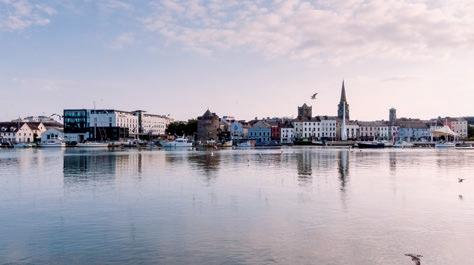
The Tower Hotel and Leisure Centre is located in the heart of Irelands oldest city Waterford, overlooking the Marina, surrounded by history and culture
€672 from €570 from €495 from
Royal Marine Hotel, Marine Road, Dún Laoghaire, Co. Dublin. A96 KO63
T: +353 1 230 0030
E: reservation@royalmarine.ie
W: www.royalmarine.ie

Kilkenny River Court Hotel, The Bridge, John Street, Co. Kilkenny. R95 Y104
T: +353 56 7723388
E: reservations@rivercourthotel.com
W: www.rivercourthotel.com

The Tower Hotel and Leisure Centre, The Mall, Waterford. X91 VXE0
T: +353 51 862300
E: reservations@thw.ie
W: www.towerhotelwaterford.com



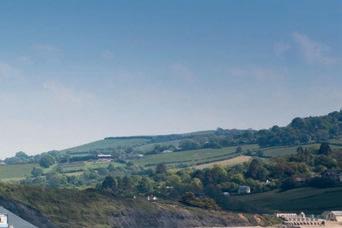

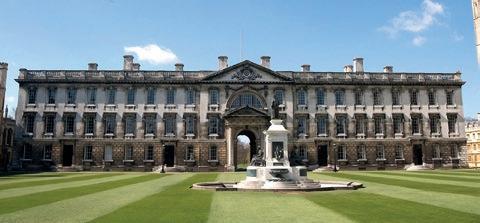
also become familiar with his books – not just at school, but through excellent films and TV series, with top directors, and Dorset locations. Some of the top actors and actress of our generation have taken on his characters – which has taken his work to a new audience. Julie Christie, Alan Bates, Terence Stamp, Peter Finch, and Gemma Arterton are just a few to have portrayed his heroes and villains. A century and a half after publication, the new generation of Hardy readers may discuss his works online rather than in person or print – but they still visit the sites, read the books and watch the films!
Dorset, has of course a wider literary legacy. It is also noted for the pretty Lyme Regis, an unspoilt picture perfect seaside

town, retaining its ancient Cobb – which forms its harbour. Authors have used it as inspiration, from Jane Austen, in Persuasion Woman. The area also has plenty for

contemporary tastes – Ian McKellan sited his novel, On Chesil Beach on the iconic site, which provided background for his novel of that name.
Hardy’s country on TV and film
Dorchester becomes Casterbridge. Henchard’s House is now occupied by Barclays Bank Puddletown doubles as Weatherbury, and Marnhull changes name to Marlott
Waterstone Manor was Bathsheba’s house, and Druce Farm, Boldwood’s farm
Maiden Newton provides the backdrop for Troy’s seductive swordplay, Batcombe Hill overlooks the Vale of the Little Dairies, in reality, the Blackmore Vale
Cranborne Chase is the literary site of the seduction of Tess.
Useful websites
www.visit-dorset.comIn the latest of her literary-themes
www.hardysociety.org:
www. nationalttrust.org.uk wessexmuseums.org.uk
www.thomas-hardy-explorer.co.uk
www.discoverdorchester.com





WHIST BREAK
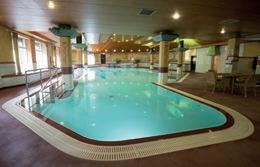
Sunday 9th to Thursday 13th June 2024
£345.00 per person
Soup and Roll on arrival
for 4 nights Bed, Breakfast and Dinner No Single Room Supplement
Welcome to Glenavon House Hotel
Set in nine acres of mature grounds, the Glenavon House Hotel, Cookstown, Co Tyrone, offers first class comfort with its central location within Mid Ulster making it an ideal base as it is a one hour drive to anywhere in Northern Ireland.
Enjoy a 4 course meal every evening followed by a Whist session
Music & dancing every night
A day trip to Giants Causeway
For bookings contact:
Glenavon House Hotel
52 Drum Road, Cookstown, Co.Tyrone BT80 8JQ
T: +44(0)28 8676 4949
E: info@glenavonhotel.co.uk
W: www.glenavonhotel.com

ComReg stands for the Commission for Communications Regulation. We are an independent public body with powers under law.
We regulate the electronic communications sector, which includes phone, broadband and radio, and postal services like An Post.
We try to make sure you are treated fairly by your service provider by:
• Telling you about your consumer rights so that you can make informed decisions.
• Making sure you have affordable access to basic services such as a home phone and a postal service.
• Making sure measures are in place for vulnerable and disabled consumers.
• Making sure that service providers provide user-friendly complaints handling process.
• Helping to find an acceptable solution if you and your service provider can’t directly solve your complaint.
• Monitoring service providers’ practices and how they comply with consumer protection laws, and taking enforcement action where required.
How can we help you with your service provider?
Our Consumer Care Team
If you have a complaint, we will review it and engage with your service provider on your behalf as long as:
1. You have already made a formal complaint to your service provider; and
2. Your complaint has not been resolved after 10 working days or more.
Our website
We provide you with independent information on ComReg.ie and useful tools:
- Compare Tool: To help you compare the costs for mobile phone, home phone, broadband and TV offers. Visit comreg.ie/compare
- Mobile Coverage Map: service providers’ mobile phone coverage at different locations throughout the country. Visit
- Premium Rate Checker:
Premium Rate Service (PRS) name and number (for example, 57XXX) that you may plan to use or have been charged for. Visit comreg.ie/servicechecker

What can we can help you with?
We deal with a wide range of issues including:
Billing: Have you been overcharged, or charged by two service providers for the same service? Or, have you been billed for a service that you don’t recognise?
Contracts: Have you received a notice that your bill is increasing? Were you given the wrong price for your contract when you signed-up?
Service issues: Have you experienced a loss of service or mobile coverage?
Switching: Have you experienced a delay in changing to a new provider? Have you lost your phone number and you are finding it difficult to get it back?
Premium Rate Services (PRS): Is there a number (for example, 57XXX) on your bill that you don’t recognise? Or having difficulty unsubscribing from a service that continues to charge you?
Postal services: Has an important letter or parcel gone missing and can’t be retrieved?
What should I do when making a complaint to a service provider?
• Act promptly, as there can be timeframes within which complaints can be made.
• Refer to the service provider’s Code of Practice for complaints handling on their website or by calling their helpline.
• Be specific that you wish to raise a complaint.
resolve your complaint.
• Keep a record of the date and time that you make your complaint.
• Ask if there is a specific complaint reference number for your complaint and make note of it.
• Make a note of any promises made by your service provider.
What should I do if I am dissatisfied with how my complaint is handled or with the outcome to my complaint?
Ask how your complaint can be progressed by your service provider in line with their Code of Practice. This may be passed to a team leader, supervisor or manager who can help with more complicated consumer complaints. If you feel that your complaint was not dealt with properly after completing your service provider’s complaint procedures, please contact us.
Contact our Consumer Care Team
The Consumer Care team is available to assist you, or your authorised representative, 8am to 8pm Monday to Friday and 9am to 1pm on Saturday (excluding public holidays).
Web: ComReg.ie for online complaint form and live web chat
Email: consumerline@comreg.ie
Phone: (01) 8049668
Text : COMREG or ASKCOMREG to 51500 to receive a call or text back (standard SMS rates apply)
Post: Consumer Care Team, ComReg, One Dockland Central, Guild Street, Dublin 1 D01 E4X0


















The dreaded pandemic brought our love of cruising to an abrupt halt. Then just as restrictions started to lift, climate change stood up as a serious challenge to all modes of travel including road, sea and air. Sustainable tourism meant climate action had to be tackled and it was necessary to lessen pollution from gases and divert waste from landfills, and also to reduce waste volume. So the challenge for cruise ships is to decrease the amount of greenhouse gases they emit into the air and also the volume and impact of waste produced on board. Sustainability has become the buzzword for all types of travel, including cruising and so reducing the carbon footprint is now a priority.
My research into how the industry is dealing with the challenges of climate change brought me to the new Excelclass vessel Arvia, which was launched in December 2022. It is pioneering the use of new fuel LNG and is on track to reduce carbon intensity by 40 per cent by 2030. Together with that key development, it is also taking steps to divert waste from landfills by recycling and also reducing single-use plastic by more than 50% while also reducing food waste per passenger. These steps result in a reduction in food loss and waste across every aspect of food preparation, consumption and disposal.

Of course the challenge with employing such measures is to ensure that the result does not impact negatively on the guest experience on board the ship. And indeed as cruising is now more popular than ever, guests are looking for even more luxury and experiences to enjoy on their chosen ship. Dining options are often one of the most important considerations when people are choosing which cruise to take, and so from Fine Dining restaurants, to several buffet stations, and many in between, the cruise ship has to provide a host of options, while also taking the impact of food waste into consideration. On our recent cruise with Arvia , we were certainly not disappointed. Freedom Dining at Zenith and Meridian Restaurants was consistently very good, be it breakfast, lunch or dinner. Also included was The Olive Grove – a delightful Mediterranean style restaurant which we loved. The 6th Street Diner is a real fun ‘honkey tonk’ style American eatery which is also included and then The Quays has lots of food offerings throughout the day, from Pizza, Asian dishes, great Fish & Chips to classic roast dinners. The Horizon offers buffet dining all day long also.
What we discovered was that while the included dining options were more than adequate, we tried out the speciality restaurants too, where for a small
exceptionally good. The Epicurean was superb – we had lobster, caviar, Dover Sole and fine wine in a classic setting –however it was Green & Co, Mizuhana that really surprised us. We had the most excellent Sushi, prepared by a Sushi Master which surpassed any we have ever come accross. All the plant based dishes were lovingly presented, service was great and it was the stand-out meal of our cruise. The other great dining surprise was The Beach House, where we once again enjoyed outstanding dishes -it was just like being back in Mexico. So there is no shortage of options as including all the bars and cafes, there are more than thirty places to eat and drink on board.
Arvia is a large cruise ship, it caters for more than five thousand guests, and while some people prefer smaller ships – less than one and half thousand guests - others prefer the larger ships and all the extra facilities that the bigger ships offer. As the debate continues, one thing really



Kind gifts in Wills have helped to bring lifeboat volunteers like Dan safely home for almost 200 years. Request your free RNLI Gifts in Wills Guide and you can help protect future generations of crew too.

Three easy ways to request your free RNLI Gifts in Wills Guide:
1. FREEPOST: Complete and return the form below
2. ONLINE: RNLI.org/ST
3. BY PHONE: 01 511 9870


Volunteer Coxswain Dan Potter: MY GREAT UNCLE VOLUNTEERED AT NEW QUAY RNLI IN 1928
30 YEARS SERVING AS A VOLUNTEER COXSWAIN
A gift in your Will to the RNLI – large or small – really will make a difference
To receive a free, no-obligation Gifts in Wills Guide, fill in the form below and send it to: RNLI Gifts in Wills, RNLI Airside Business Park, Swords, Freepost FDN 7597, Co Dublin, K67 WA24 (no stamp required)
Title: Full Name:
Address:
Eircode: Phone:
Email:
Your support saves lives, and we look forward to keeping in touch with you by post and phone, sharing our news, activities and appeals.
Would you like to receive our emails and text messages too?
Yes, I’m happy to hear from you by email
Yes, I’m happy to hear from you by text
Even if you have received our communications in the past, we’ll make sure we honour the preferences you express here.
Privacy Notice: We will always store your personal details securely, and they will only be used by the RNLI, RNLI Shop and RNLI College. Your data may also be used for analysis purposes, to help us provide the best service possible. We will only allow your information to be used by suppliers working on our behalf and we’ll only share it if required to do so by law. We will need to share your details with Capacity Marketing who run the scheme and will only use your details to contact you about making a Will for free. Please see their Privacy Policy at freewillsnetwork.ie/privacy-policy. For full details see our Privacy Policy at RNLI.org/PrivacyPolicy or contact our Supporter Experience Team on 01 511 9837
The Royal National Lifeboat Institution (RNLI), a charity registered in the Republic of Ireland (CHY 2678 and 20003326), England and Wales (209603), Scotland (SC037736), the Bailiwick of Jersey (14), the Isle of Man (1308 and 006329F), the Bailiwick of Guernsey and Alderney, of West Quay Road, Poole, Dorset, BH15 1HZ
Photo: RNLI/Nathan Williams ABZLGA165 ABZLGA165stood out for us. While this was certainly the largest ship we have sailed on, sailing was serene, our accommodation was quiet and peaceful and everything seemed to run like clockwork. Organization was top notch.
Much of our private and peaceful cruising experience came from our brilliant accommodation. Having enjoyed balcony cabins previously, Arvia now offers a Balcony Conservatory Mini Suite, which basically added a sunroom between our cabin and balcony, allowing extra space and so much light. There is actually 274 sq ft. of space, including the balcony. This extra area was wonderful, and with retractable glass doors both sides, the whole cabin can be opened out to the balcony. Only available on Arvia and sister ship Iona, but without a doubt for us it was the most luxurious cruising accommodation option, and we loved it.
Arvia’s sustainability protocols include pleasantly surprising details such as sheets of biodegradable detergent to use in the guest laundries – very welcome especially on a longer cruise. And of course with all the wining and dining we enjoyed, we were able to keep fit in
the very well equipped gym which we used most days and there was never a queue. In fact surprisingly, we never had to queue for anything, such was the clockwork efficiency on board. And for a treat, there was also the pampering spa –with special treatment offers daily. Entertainment was plentiful and varied for all tastes and interests and Arvia also boasts a unique Sky Dome with a retractable glass roof, which features the first high ropes experience at sea! Concerts, games, musicals, talks, comedians, disco parties – there really is something for everybody along with extensive shopping options. You can also chill out in the super cool 710 Club where we enjoyed stylish cocktails and live music in a sophisticated atmosphere.
Like many Irish people, we love a Mediterranean cruise, where we can explore our favourite cities like Malaga, Barcelona, Cadiz and Lisbon. But for those who fancy more exotic destinations, Arvia also sails to the Carribbean and visits Antigua, Barbados and Martinique, among other islands. They also sail to the Norwegian Fjords, where you can cruise through the deep-blue waters of Norway’s UNESCO-

Why Donegal? Boasting Ireland's longest coastline, over 100 unspoiled beaches, and Europe's highest sea cliffs, Donegal promises a unique travel experience for both domestic and international tourists. Whether you're seeking breathtaking landscapes, cultural immersion, or a peaceful retreat, Donegal has it all.
Lonely Planet's Praise: Lonely Planet commends Donegal for its pristine coastal hiking trails along the Wild Atlantic Way, making it an ideal destination for those seeking a tranquil escape. The county's ancient forts, vibrant musical traditions, and rich heritage of the Irish language provide an immersive experience for inquisitive travellers.
protected fjords, one of the most spectacular regions of the world. Now that is a trip that would be on many a bucket-list!
As cruising has now become more popular than ever – over 30 million will take to the oceans in 2024 - it is great to see how a combination of sustainability focus together with enhanced guest experience is making this type of travel top of the holiday list for people of all ages.
Sailing from Southampton is just a short Aer Lingus flight from Dublin, and this helps keep the carbon footprint down. And while the guests are mainly from all over the UK, we met so many people with Irish connections, that we felt very happily at home. A future-focussed ship with exceptional comfort and facilities, ARVIA is our top pick for ocean cruising.
For more information on your Ariva cruise check out:- www.pocruises.com From Ireland you can also contact:Sunway, Marble City, John Galligan , Cassidy Travel and Shandon Travel.
Key Highlights:
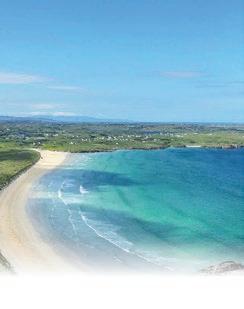
• Longest Coastline in Ireland
• Over 100 Beaches:
• Europe's Highest Sea Cliffs:
• Pristine Coastal Hiking Trails:
• Ancient Forts:
• Vibrant Musical Traditions:
• Irish Language Heritage
Book your Aer Lingus flight, and let the adventure begin! For bookings go to www.aerlingus.com

With thousands customers across every county in Ireland, the ACORN is Ireland’s first age-friendly smart tablet. Used by individuals and over 90 Irish support organisations supporting going online easy for our users. Join Zoom / Whatsapp calls or use our simple Video talk feature, browse the web or use popular apps. ACORN is designed with you in mind.
Our local telephone support team are there to hel p you too. Call us to learn more.
085 888 1657
No Wifi or broadband at home? No problem! The ACORN comes with a mobile data service option connecting you to the internet at home and on the go.










Michael O’Loughlin has enjoyed teaching bridge for over 40 years; his book, “Bridge: Basic Card Play” is available from the Contract Bridge Association of Ireland (01 4929666), price: €10.
The Rule of 18
We are all used to using point count to evaluate a hand: 4 for an Ace, 3 for a King, etc. and it works pretty well when the hand is balanced or semibalanced. But what can we do when our hand is unbalanced i.e., very shapely? The high card point count isn’t so accurate. It’s possible to have a hand with few points but enormous playing strength.
Fortunately, we have a brilliant tool to use, called the LOSING TRICK COUNT.
It is so useful it should be part of every bridge player’s system. The Rule of 18: The Losing Trick Count: With 4+ trumps and an unbalanced hand, add your losing tricks (LTs) to partner’s presumed number of losing tricks. Subtracting the total from 18 will tell you the level at which to bid.
Using the Losing Trick Count (LTC)
So, when can we use the Losing Trick Count? Here’s a useful mnemonic to help you remember when you can use it: UFO.
• U is for Unbalanced hand. If your hand is balanced, just bid as you normally would, based on your point count.
• F is for when you have found a Fit
• O is for when you are the Opening side i.e., don’t use it when the opposition have opened and your partner has overcalled.
How to calculate your Losing Tricks (LTs): OK, let’s say you’ve established you have a fit with partner, your side is the opening side, and your hand is unbalanced. Now you are going to count up your LOSING TRICKS. It’s a bit of arithmetic but you will get quicker at it with practice. Look at each suit in turn. Only consider the first 3 cards you hold in each suit: by definition, the maximum number of losing tricks you can have in a particular suit is 3, and therefore, in your whole hand of 4 suits
have only two cards in a suit, count each missing Ace and King as a Loser. If you have only one card in a suit, count each missing Ace as a Loser. A void, of course, counts as 0 LTs. Add up the LTs for all 4 suits, and that is the Losing Trick Count for your whole hand. Examples: A 6 5 = 2 LTs; K Q 9 = 1LT; A J 9 6 2 = 2LTs; K 7 4 2 = 2 LTs; Q 6 = 2LTs; 9 7 6 3 = 3 LTs; 9 = 1LT; A 2 = 1 LT; K = 1LT. And now for a complete hand:
(1) (2) (3)
by Michael O’Loughlin(1) We call the first hand a “7 loser hand”: 1 in Spades, 3 in Hearts, 2 in Diamonds and 1 in Clubs.
(2) The second a “5 loser hand”: 1 in Spades, 2 in Hearts, 0 in Diamonds and 2 in Clubs.

(2) The second a “5 loser hand”: 1 in Spades, 2 in Hearts, 0 in Diamonds and 2 in Clubs.
(3) And the third a “9 loser hand”: 3 in Spades, 3 in Hearts, 1 in Diamonds and 2 in Clubs.
(3) And the third a “9 loser hand”: 3 in Spades, 3 in Hearts, 1 in Diamonds and 2 in Clubs.
So, how do we make use of this information?
So, how do we make use of this information?
We start by assuming that the opener has 7 LTs; that the responder who responds at the one-level has 9 LTs and that the responder who responds at the two-level has 8 LTs.
We start by assuming that the opener has 7 LTs; that the responder who responds at the one-level has 9 LTs and that the responder who responds at the two-level has 8 LTs.
Exercise: Partner opens 1♠. What do you respond with:
Exercise: Partner opens 1♠ W h a t d o y o u r e s p o n d w i t h :
(1) (2) (3) (4)
( 3 ) 3 ♠ W h e n b a l a n c e d u s e H i g h C a r d P o i n t s (3 ♠ = 1 0 n o t L o s in g T ric k C o u n t
( 4 ) 2 ♦ N o t L T C w i t h f e w e r t h a n 4 c a r d s i n
(1) 3♠. 8 LTs (♠AK, ♥A, ◆AQ, ♣AKQ) facing a presumed 7. Take 15 (8+7) from 18 – ergo 3♠
(2) 4♠. 7 LTs (♠ K, ♥AK, ◆AK, ♣AQ) facing 7. 18 – 14 = 4.
(3) 3♠. When balanced use High Card Points (3♠ = 10-12 points) not Losing Trick Count.
(4) 2◆. Not LTC with fewer than 4 cards in Spades.
Dealer: South Vul: All
Dealer: South Vul: All South West North East 1♠ Pass 4♠(1) Pass 6♠ (2) End
(1) 7 LTs (♠AK,♥AK, ◆Q, ♣AK) facing a presumed 7. 18 – 14 = 4♠.
(1) 7 LTs (♠AK, ♥AK, ♦Q, ♣AK) facing a presumed 7. 18 – 14 (2) 2 fewer LTs than the 7 expected by your partner, North –goes up 2 levels to 6♠
Opening Lead: ♦Q
have only two cards in a suit, count each missing Ace and King as a Loser. If you have only one card in a suit, count each missing Ace as a Loser A void, of course, counts as 0 LTs. Add up the LTs for all 4 suits, and that is the Losing Trick Count for your whole hand. Examples: A 6 5 = 2 LTs; K Q 9 = 1LT; A J 9 6 2 = 2LTs; K 7 4 2 = 2 LTs; Q 6 = 2LTs; 9 7 6 3 = 3 LTs; 9 = 1LT; A 2 = 1 LT; K = 1LT And now for a complete hand: (1) (2) (3)
(2) 2 fewer LTs than the 7 expected by your partner, North – so South goes up 2 .
Declarer wins and leads the ♠A. After ruffing all her Heart and Diamond losers, declarer throws West in by leading a trump. West must either into the ♣AQ or give a ruff and discard. 6♠ made.
https://www.andrewrobson.co.uk/andrew/tips_for_intermediates
(1)
(1)
A. After ruffing all her Heart and Diamond losers, declarer throws West in by leading a trump. AQ or give a ruff and discard.
More tips for Intermediate players can be found at:
https://www.andrewrobson.co.uk/andrew/tips_for_intermediates /
More tips for Intermediate players
(1) 7 LTs (♠AK, ♥AK, ♦Q, ♣AK) facing a presumed 7. 18 – 14 = 4♠.
(2) 2 fewer LTs than the 7 expected by your partner, North – so South goes up 2 levels to 6♠
than the 7 expected by your partner, North – so South goes up 2 levels to
Opening Lead: ♦Q.
Opening Lead: ♦Q.
Opening Lead: ♦Q.
(1) We call the first hand a “7 loser hand”: 1 in Spades, 3 in Hearts, 2 in Diamonds and 1 in Clubs.
https://www.andrewrobson.co.uk/ andrew/tips_for_intermediates/
Declarer wins and leads the ♠A. After ruffing all her Heart and Diamond losers, declarer throws West in by leading a trump. West must either lead into the ♣AQ or give a ruff and discard. 6♠ made.
Declarer wins and leads the ♠A. After ruffing all her Heart and Diamond losers, declarer throws West in by leading a trump. West must either lead into the ♣AQ or give a ruff and discard. 6♠ made.
(2) The second a “5 loser hand”: 1 in Spades, 2 in Hearts, 0 in Diamonds and 2 in Clubs.
More tips for Intermediate players can be found at:
More tips for Intermediate players can be found at:
More tips for Intermediate players can be found at:

Declarer wins and leads the ♠A. After ruffing all her Heart and Diamond losers, declarer throws West in by leading a trump. West must either lead into the ♣AQ or give a ruff and discard. 6♠ made.
If you wish to receive three times per week free bridge emails which include lessons, videos & quizzes, please email me: michaelolough@yahoo.com
(3) And the third a “9 loser hand”: 3 in Spades, 3 in Hearts, 1 in Diamonds
https://www.andrewrobson.co.uk/andrew/tips_for_intermediates
https://www.andrewrobson.co.uk/andrew/tips_for_intermediates
https://www.andrewrobson.co.uk/andrew/tips_for_intermediates








MiniBridge is a simplified form of the complex card game Bridge. MiniBridge is designed to introduce newcomers to playing techniques without the burden of learning a detailed bridge bidding system.
Evaluating your hand
A player needs some way to judge how good her hand is. The time-honoured way is to give a value of 4 to an Ace, 3 to a King, 2 to a Queen and 1 to a Jack.
A player needs some way to judge how good her hand is. The time-honoured way is to give a value of 4 to an Ace, 3 to a King, 2 to a Queen and 1 to a Jack. These are called High Card Points (HCPs for short) because one is allocating a Point value to one’s High Cards. These values make sense as an Ace is better than a King, a King better than a Queen and a Queen better than a Jack.
If you are familiar with the card game “Beggar my Neighbour” in which 4 cards are played on an Ace, 3 on a King, 2 on a Queen and 1 on a Jack this will help you remember.
In MiniBridge players, in turn, announce their number of highcard points. The partnership with more HCPs then plays the hand. If both partnerships have the same number of high card points (i.e., 20 each), the hand is redealt.
From within the partnership with the more HCPs, the player with more high-card points becomes the Declarer. (If both partners have the same number of high-card points then the

therefore, South has to try to win 27 ÷ 3 = 9 tricks.
1. The player on Declarer’s left leads the first card. Generally, she will lead the lowest card from the suit in which she has 4 cards because the suit she has the most cards in is potentially her best source of tricks. West decides to lead a ♥ because that is the suit in which she has the most cards. West decides to lead a low ♥ because she needs some help from her partner in order to win tricks in the ♥ suit. She starts by leading the card face down.
2. Then, her partner gives her the nod to confirm that she is the correct person to lead.
3. Now, she turns the lead card face up and the second player, i.e., Declarer’s partner, becomes Dummy. For the duration of this deal Declarer makes the decision as to which card to play each time from Dummy’s hand, as well as which card to play from her own hand.

Dummy does not take any part in the play of the cards. It is Declarer’s job, on this deal, to marshal her combined resources i.e., the cards in her own hand + those in Dummy. Declarer has
https://www.andrewrobson.co.uk/andrew/tips_for_intermediates
4. Dummy places all her 13 cards face up on the table. Dummy’s cards should be arranged in suits, facing Declarer. Dummy (North) arranges her cards from the highest to the lowest, in suits, in columns, facing towards her partner, South. For the duration of this deal Declarer (South) makes the decisions as to which card to play each time from the North hand, as well as which card to play from her own
5. Declarer should now spend a little time planning how she is


If you wish to receive three times per week free bridge emails which include lessons, videos & quizzes, please email me:


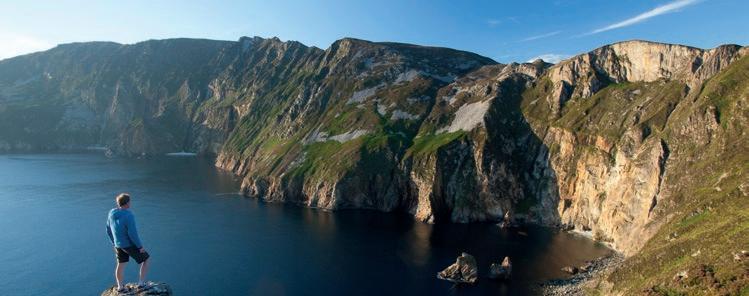







S. J. ‘Skid’ Simon (1904 – 1948). His real surname was Skidelsky but he was universally known as “Skid”. He was a member of a Russian-Jewish merchant family from Vladivostok. The family emigrated to England after the Russian Revolution and Skid became a British citizen in 1931.
He was one of the most entertaining characters on the bridge scene in the 1930s and 1940s. He lived in a flat in Baker Street – as did Sherlock Holmes – in a state of unmistakeable squalor: Empty food containers lay scattered around and porridge and claret were his staple diet. He was often unshaven, his hands stained with nicotine. He wore goggling glasses. He smoked seventy cigarettes a day, ash liberally sprinkled on his jacket. He had a potbelly. Yet his attraction to others was undeniable. After dinner in Crockford’s Club he could be seen, a balloon glass of brandy in one hand and a cigar in the other. He would approach women and say, “Give light, darling”. His thick unmistakable Russian accent was characterised by the omission of the definite and indefinite articles and personal pronouns, a habit retained from the Russian.
Skid lived to the age of 44 - by a series of miracles. He crossed the busiest street, nose buried in a book. He dismounted from buses travelling at full speed, nose still buried in a book. He once walked through a plate glass window. Sent upstairs to spruce himself before a Bridge Congress prize giving, Skid was discovered by an irate lady resident of the hotel, calmly brushing his hair in front of her dressing table. Not in the wrong room, as he indignantly stated - merely on the wrong floor.
One remembers the mane of black hair, the shuffling gait, the unlaced shoes; the moment of agony when he went up to collect his winner’s trophy, wondering whether (as usual) the more
important buttons had been left undone. His humour always touched the human comedy, but never with malice. For example: A lady who held an ace and was on lead against 7 No Trump neither doubled nor led the ace. The contract was made and the story of her twin omissions quickly made the rounds. It was Skid who pointed out that she must be acquitted on at least one count: If she was not going to lead the ace, she was quite right not to double!
Simon, together with Jack Marx, coinvented the hugely popular Acol bidding system.



He was author of Why You Lose at Bridge (1945); a classic book which, among other things, introduced to the world four archetypal losing players: Futile Willie, Mrs Guggenheim, Mr Smug and the Unlucky Expert. This evergreen classic is now almost 80 years old but is certainly not ready for retirement! It is humorous and practical, concentrating on the unspectacular but effective ways to avoid making mistakes and make the most of your cards - and your partner. The first part, on technique, is interesting; the second part, on the psychological aspects of playing with different partners, is virtually unique.
had more realistic expectations of what a partner can remember or deduce in a bidding system (unlike the Unlucky Expert)!
S. J. ‘Skid’ Simon (1904 – 1948). His real surname was Skidelsky but he was universally known as “Skid”. He was a member of a Russian-Jewish merchant family from Vladivostok. The family emigrated to England after the Russian Revolution and Skid became a British citizen in 1931.
This book is full of charm, wit and humour throughout and teaches Bridge players the best 'Winning tactics'. This book is the perfect gift for anyone who is always asking you to be their partner. It really focuses on the essentials, on how to think at the bridge table, and how to remain realistic, especially if you are playing with different partners. And if you have an established partnership, read it together.
He was one of the most entertaining characters on the bridge scene in the 1930s and 1940s. He lived in a flat in Baker Street – as did Sherlock Holmes – in a state of unmistakeable squalor: Empty food containers lay scattered around and porridge and claret were his staple diet. He was often unshaven, his hands stained with nicotine. He wore goggling glasses. He smoked seventy cigarettes a day, ash liberally sprinkled on his jacket. He had a potbelly. Yet his attraction to others was undeniable. After dinner in Crockford’s Club he could be seen, a balloon glass of brandy in one hand and a cigar in the other. He would approach women and say, “Give light, darling”. His thick unmistakable Russian accent was characterised by the omission of the definite and indefinite articles and personal pronouns, a habit retained from the Russian.
We meet people like the Unlucky Expert, the well-meaning but incompetent Mrs Guggenheim, Mr Smug and Futile Willie (the "very bad good player", who uses conventions without real understanding) in our clubs - and if we are honest, we recognise something of them in ourselves. Of course some of the material is dated - bidding has changed considerably since then on both sides of the Atlantic, and the examples concentrate on rubber rather than duplicate bridge - but the key insights come up as fresh as ever. I would definitely have had better results in the last 10 years if I had read this book earlier, for example because I would have
Skid lived to the age of 44 - by a series of miracles. He crossed the busiest street, nose buried in a book. He dismounted from buses travelling at full speed, nose still buried in a book. He once walked through a plate glass window.
Walking the fine line between being too aggressive or too conservative is the key to success in bridge, and this book has good advice on how to fine-tune your approach. The advice to adjust your strategy to the scoring system rings as true for duplicate games today as when this book was written and can spare you making many bad decisions (and help you make many good ones!), once this way of weighting the pros and cons of a particular action at the table is internalised.
To read the book for free search for Why You Lose at Bridge on books.google.com
S.J. ‘Skid’ Simon taught his team-mates to play and to laugh.
STAMPS, POSTAL HISTORY, COINS, BANKNOTES, MEDALS & POSTCARDS
R.D.S. BALLSBRIDGE DUBLIN 4 ANGLESEA RD ENTRANCE
Sunday, 21st April 2024. Open 11am To 5pm
Adm €6.00
Great Variety Of Stamps, Postal History, Coins, Tokens, Medals, Banknotes, Postcards & Accessories
Leading Irish & Overseas Dealers, Selling & Buying
Free Expert Valuations Bring Your


Memories are made at Castlemartyr
Active Retired Break, from €329 per person sharing
2 nights bed and breakfast
Tea or coffee and homemade scones on your arrival
Lunch on one day of your choice
4 course dinner on one evening
To make a reservation contact us on 021 421 9000, or email reservations@castlemartyrresort ie, or book online on www castlemartyrresort ie



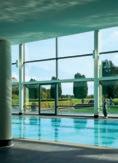






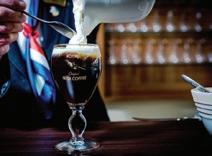 Castlemartyr, Cork, P25 X300, Ireland
Castlemartyr, Cork, P25 X300, Ireland
George Keegan on what’s happening in travel, the arts, food and entertainment along the Western Seaboard






The Wild Ireland animal sanctuary is situated at Dundrain, near Burnfoot in County Donegal. Visitors can enjoy viewing more than a hundred animals which have been rescued. The impressive list includes wild boar, red, arctic and silver foxes, snowy owls, red deer, wildcats and lynx. Wallabies can be seen wandering around and more common creatures such as swans, geese, ducks and otters.
The Sanctuary, described as a small area of Celtic rainforest, covers 23 acres and was set up by Killian McLaughlin and his wife Katie. Their project to construct a world class wildlife sanctuary was an ambitious one and they have encountered many difficult hurdles from the outset. Both have a passion for conservation and taking back Irish fauna from the brink of extinction. Since the sanctuary was established a total of 10,000 native trees have been planted.
Regarding the animals the focus from the beginning has been on species once native to Ireland so they all are able to adapt easily to the Donegal environment. Many of these animals however cannot be released into the wild as they would not be able to cope with either finding food or know how to avoid predators and indeed humans.
At Wild Ireland all the animals receive exceptional care from a team of wildlife experts. Veterinarians are available 24 hours providing excellent care and attention.
Killian points out that they receive numerous requests to help animals in need and always strive to assist whenever possible. ‘Currently we are working on our biggest rescue ever of two brown bears from Russia and despite recent challenges of Covid 19 and the war in Ukraine, we remain committed to provide them with a better life” he says. Next up are plans to extend the current bear habitat to a 2 acre Bear Wood and develop the

wolves area. It is also intended to construct otter falls so visitors can observe these wonderful creatures’.
He points out too that while some sanctuaries genuinely prioritise animal well- being some coerce their animals into posing for photographs or to have contact with paying tourists. Even drugging tiger cubs has been known to happen which are then disposed of on reaching adulthood. So the message is to conduct a thorough research before visiting such places and refrain from having photos taken beside what are after all wild animals.
Killian believes it is so important to make a change to Ireland’s bio-diversity through education, conservation and rescue, as well as restoring the natural environment through native planting. The general public are invited to donate to the charity Wild Ireland Foundation or get involved by purchasing an adoption pack for an animal of their choice.
The Centre is open all year (except three days at Christmas), from 10am to 4pm daily. Before visiting you can book a tour on- line but it’s not essential. All paths are flat making it easy for senior citizens, wheelchair users and parents with prams. Last year 130,000 visitors were welcomed at the Sanctuary. There is free car parking, a play area for children, café serving hot drinks and light snacks and gift shop to purchase souvenirs of your visit. In summertime there are facilities suitable for having a picnic.
Christmas 2024: All grandparents should take note that The Wild Arctic Experience will take place here from 1st – 23rd December with the opportunity to meet Santa plus his reindeer and view the arctic animals. There will be a special light display and children will receive a present from Santa. The perfect present for the grandchildren! Click on www.wildireland.org



Everyday life can be quite exhausting but BioActive Q10 can help you in a natural way.
The combination of the vitamin-like compound coenzyme Q10 and vitamin B2 that contributes to normal cellular energy turnover is the perfect boost



Scan to learn more

when your batteries are low. BioActive Q10’s good absorption and bioavailability are documented in multiple scientific studies, which is why it is the leading Q10 brand on the market.






The Original Q10 preparation
Sign up to receive the latest information about health and food supplements based on science. Sign up here: www.pharmanord.ie






In the small picturesque town of Newport in North Mayo there are now new life size statues in different parts of the town dedicated to two Graces – Grace Kelly (20th C) and
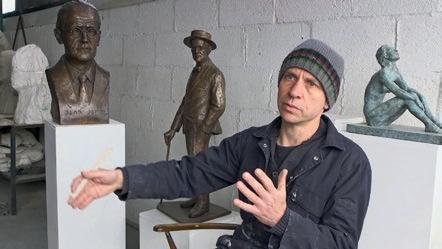
Following on from the unveiling of the first statue in March last year by His Serene Highness Prince Albert 11 of a statue dedicated to his mother Princess Grace of Monaco, a second statue dedicated to Grace O’Malley was completed earlier this year. Grace O’Malley or Gráinne Uaile (known as the Pirate Queen) is portrayed standing at the bow of her boat which is pointing to Clew Bay. Throughout history she has been recognised as a protector of the bay and also the Barony of Burrishoole. A woman certainly famous for her bravery and leadership.
She was born on Clare Island in 1530 and lived for many years at Rockfleet Castle not far from the town. Its thought she died there in 1603 and was buried on the Island.
At the unveiling of the statue in January several members of the O’Malley Clan were in attendance and Chieftain of the Clan, Nano O’Malley McMahon addressed the large crowd. This statue is located at Meddlico Street.
Famous Hollywood actress Grace Kelly, later to become Princess Grace of Monaco, is connected to Newport through her grandfather John Henry Kelly who lived outside the town before emigrating to the US in the mid 1800’s. Grace visited the town on several occasions, the final one taking place in 1979. She was interested in examining the possibility of constructing a holiday home on the original family site. Those plans never reached fruition as sadly she was killed in a car accident 3 years later. Her statue in Castlebar Street shows her sitting on a bench.
The sculptor
One of Ireland’s most prestigious and talented sculptors Mark Rode was commissioned for both statues. He has produced many highly praised public statues around the country such as a bronze bust of President Obama (Moneygall), Titanic Memorial (Addergoole, Co. Mayo), The Quiet Man (Cong) and Tour de France in Enniscorthy, which was unveiled by Irish cyclist Sean Kelly.
Because Newport is situated at the heart of The Great Western Greenway the local Business Association is confident the new statues will attract many more visitors to the town which in future will be known as Newport ‘The Town of the Two Graces’.
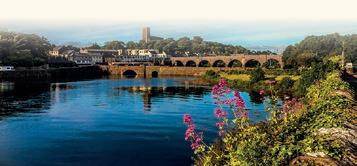
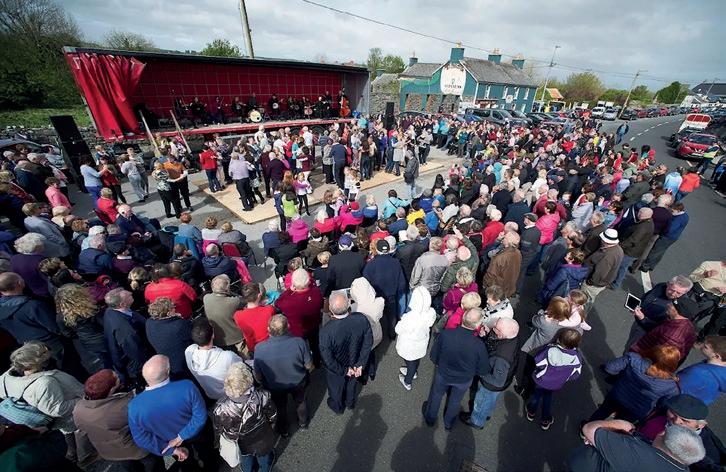
The popular Kilfenora trad festival will take place in April
Each year our patron saint is celebrated around the 17th March which of course means parades large and small taking place in many cities, towns and villages throughout Ireland and overseas. Be sure to check the day and time it will be held in your location.
Other March Festivals:
Limerick Early Music Festival 22nd & 23rd. taking place in various churches around the city. Established to promote early repertoires from around the world. Events include ‘Journeying with Bach’ and ‘The Fragrant Garden: from Al-Andalus to North Africa.
Two Music Festivals In April:
The annual Kilfenora Traditional Music Festival takes place in the County Clare town from 26th-29th.
Clifden Traditional Music Festival is expected to be take place on the week-end of 14th with best of music, song and dance. It will feature a host of fine musicians. This year All Ireland champions The Blackwater Céilí band will appear live on Saturday night.



Claregalway Spring Garden, Craft & Food Fair is expected to be held on 7th April (not yet confirmed)
An ideal opportunity for garden lovers to speak informally with experts. Some of the country’s best nurseries and plant specialists will be in attendance.
Limerick City: The Catalyst International Film Festival is from 18th-20th. Described as Ireland’s flagship film festival addressing under-representation in the film industry. Showcasing a diverse range of genres with something for everybody.
USEFUL WEBSITES
www.discoverireland.ie
www.galwaytourism.ie
www.kilfenoraclare-trad-festival-2024 www.clifdentradfest.ie
www.limerickearlymusic.com www. catalystinternationalfilmfestival.com

George Keegan travels to Derry to take in some of the city’s attractions as well as sampling a recently opened hotel on an historic site.. He also looked at some places to visit in neighbouring Donegal.

Close to the Ebrigton Hotel in the Waterside you will discover a river walk and St. Columb’s Park both ideal for a leisurely stroll and just a 5 minute walk across the Peace Bridge brings you into the heart of the city centre close to several attractions which include;
The Walls: Go for a walk around the 400 year old walls which have the longest complete circuit of ramparts in Ireland. View the restored canons and visit the impressive St.Columb’s Cathedral. Enter the walls through Magazine Gate in Guildhall Square, one of four original gates.
Tower Museum: The permanent exhibition here is all about the city’s history. From time to time temporary exhibitions also take place. Currently on display is ‘Peace Heroines’ exploring the collaboration of women from the locality working across borders and political/religious divides.
The Guildhall: Entrance is free or take a guided tour (£2 pp) of this superb building with its stained glass windows and a huge concert organ, the 2nd largest in Northern Ireland with 3,132 pipes. Now on view to the public is a collection of awards and accolades presented to the late John Hume, including the 1998 Nobel Peace Prize.
The Bogside: Outside the walls this area of the city is now famous for the giant murals on the gables and the Museum of Free Derry relating the history of The Troubles.
The Derry Girls: go on a guided tour of the locations used for this highly successful TV series.
Peacemakers Museum: Due to open this summer at the redeveloped Gasyard Centre.
A Wee Gem: Be sure not to miss a small space hidden away on Bishop Street called the Garden of Reflection. It is a peaceful small outdoor area aptly described by locals as ‘a place of contemplation’. There are quirky street sculptures, unusual pavement designs and small fountains. Outdoor tables and seating are available on summer days. The garden was funded by the PEACE 111 Programme as part of the EU Regional Development Fund.
There is a large spacious Tourist Office situated at Waterloo Place in a brand new building where the impressive Ulster Bank once stood until it was blown up during the Troubles. Don’t forget to purchase a one or two- day Visitor Pass giving access to 10 handpicked attractions, complete with Visit Derry map.
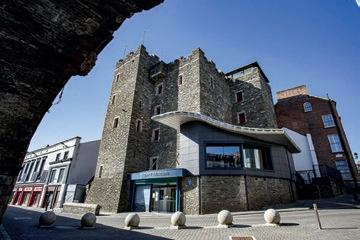








Every Monday, Seniors can discover the heart and home of Gaelic Games with these exclusive offers designed for your pocket, as well as your passion! Both tours include admission to the GAA Museum.
This year the Abbey Theatre enters its 120th year as the National Theatre of Ireland.
We continue to value the generosity of our patrons, who support us in nurturing the artists Ireland is home to. Become a patron today and join the community of theatre lovers who enjoy a unique connection with the Abbey Theatre.
ONLY
€10
Our friendly and knowledgeable tour guides will take you through the fascinating story of Croke Park stadium, the home of Gaelic Games. This guided tour will bring you through the dressing rooms, media centre, corporate levels, and of course, pitch-side!
ONLY
€17
Are you ready for a 17-storey high? This Dublin City tour highlights all of the capital’s main landmarks while giving you an insight into its heartfelt history, all from the rooftop of Croke Park Stadium!
For more information and booking, visit crokepark.ie/seniors or call 01 819 2374

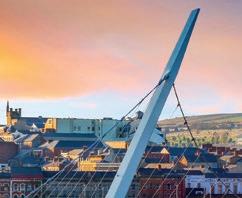






Just a short distance from the city The Wild Atlantic Way starts, stretching as far south as Kinsale in County Cork. In fact, Derry is where the Wild Atlantic Way meets The Causeway Coastal Route. Using the city as a base there are lots of interesting places in North County Donegal. Malin Head is Ireland’s most northerly point where you can discover ancient ruins, large sand dunes and for nature lovers basking sharks and great birdlife. Fanad Head stands between Lough Swilly and Mulroy Bay with a stunning lighthouse which is open for guided tours. Glenveagh National Park & Castle a little further away extends over 16,000 hectares.

The bustling town of Letterkenny also on the banks of Lough Swilly is just 40km from the city. Dominating the town’s skyline is the 19th Century Saint Eunan’s Cathedral. Here too some interesting historical architecture such as the Courthouse built in 1829, one of the few remaining examples of the old style courthouse buildings. Visit the County Museum, originally the Workhouse, with artifacts from the pre-historic period up to the 20th century. It is situated on High Road.
Golf enthusiasts have a choice of courses both in the Derry city area or Buncrana and Donegal Golf Clubs.
There are several excellent beaches within easy reach of the city with Dunree and Stroove both just a 45 minute drive away.
Useful websites
www.visitderry.com
www.guildhallderry.com
www.discovernorthernireland.com
www.ebringtonhotel.com
www.discoverdonegal.ie
It is always exciting when a new hotel is announced in any city and Derry/Londonderry is no exception. A great buzz so when the four star Ebrington opened its doors in July last year. This city with its 400 year old walls has progressed in leaps and bounds since the end of ‘The Troubles’ and has become a very popular city-break destination for people both north and south. There is an electric atmosphere, some excellent restaurants and many attractions to enjoy.
The earliest records suggest that the site where the Ebrington now stands was once an orchard with numerous fruit trees, rather than a forest with oak trees which was to give the city its name, Doire meaning Oak Grove. During the reign of King James II it was here he placed canons to fire at the walled city just across the river Foyle.
Moving forward to the period of World War Two the building was used as a base for American, Canadian and British forces. It became a centre for North Atlantic convoy escorted missions. When peace was declared the barracks remained in operation as an anti-submarine training base. In 1970 it reverted to a British army base remaining so until finally vacated in 2003. Some eight years later the site was opened to the public. That same year 2011, the iconic Peace Bridge was completed giving pedestrian access across the river from the city centre to the Waterside area.
In 2022 work began to transform the building into a new luxury hotel with great care being taken of its exterior, particularly the famous clock tower and former captains house, both retaining their original appearance. The Ebrington has 89 bedrooms with choice of De Luxe single/double plus several rooms with a river view. For that extra special occasion customers can book the Signature Suite. All the work in the hotel’s interior was designed by well-known interior designer Eamon Carberry who has produced exclusive designs both contemporary and traditional in many establishments throughout Ireland and the UK.
The hotel has a Spa described as a sanctuary of tranquillity where mind, body and wellbeing take centre stage. There is a Hydrotherapy pool, a Classical Sauna, Steam Essence Room and a Bubble Spa Experience shower. In the Therman Suite are six rooms used for facial, full massage and body treatments. Those who can muster up some extra energy can head to the Fitness Centre and Gym. There are three conference areas, one of which can hold up to 300 people. Weddings are another of the hotel’s specialities with first class facilities and bookings for 2024 are selling fast.
Food is of course an important part of a stay in any hotel and the Ebrington does not disappoint in this regard. Meals are served either in the Oak Room restaurant or Corner House bar. This fine hotel certainly offers a feeling of relaxation and staff are friendly and professional. The perfect location to enjoy a city break.





Pat Keenan reports

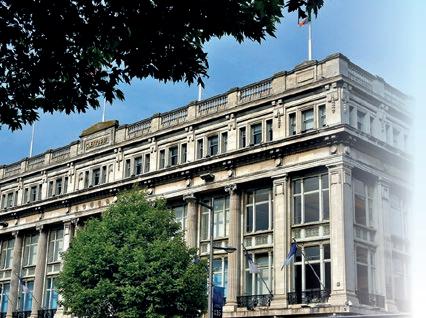
Just back in November last year Parnell Square was the scene of intense violence and arson attacks following the stabbing of three children and their carer outside Gaelscoil Coláiste Mhuire.
What shocked most was how quickly it all escalated that Thursday into riots extending down into O'Connell Street and beyond, how quickly it started and spread and how it appeared so organised. The violence directed at the gardaí, the burning of cars, buses and trams all seemed so orchestrated. Gardai called it a “lunatic, hooligan faction driven by farright ideology.” The Minister for Justice Helen McEntee condemned the attacks on gardaí by a "manipulative element.” The following day Friday the debris was mostly cleared and shops were open again for business by midday. The looters had also attacked and broke into shops off O'Connell Street. Arnotts in Henry Street was broken into and pillaged.
A 50 year old man was quickly arrested and would later appeared in court charged with attempted murder. He's awaiting trial.

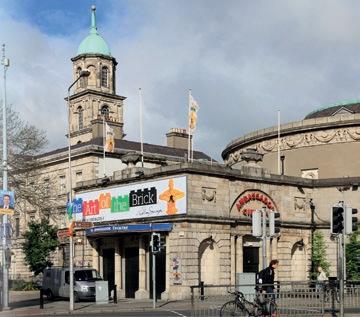
The riots drove home the need to examine what our capital city's main thoroughfare has become. For years now O'Connell Street has been neglected, deserted buildings, lands long awaiting redevelopment and dodgy-looking people lurking against walls. Rightly or wrongly it has created a perception amount mostly middle class people that these areas are to be avoided, particularly at night.
Clerys closed after 162 years in business in 2015 still lies vacant. Acquired by the Natrium investment group, they have since been granted planning permission by Dublin City Council for a mixed-use scheme on the site involving offices, retail units, leisure facilities and a boutique hotel. But progress has been slow. To date the Frasers retail group plan to open Flannels selling designer clothing, accessories and footwear for men, women and children. H&M clothing company, already in Henry Street, also plan a new store in Clerys. The Carlton cinema closed in 1994 and is still a vacant site. An Post has moved offices from the GPO to a new building in the north docks.
Debenhams on Henry Street remains empty but there are plans by the Frasers to open a Sports Direct as its Irish flagship store selling sports and fitness footwear, clothing, and equipment. Tessuti’s plan their first Irish store retailing men’s and women’s designer collections, clothing, shoes and accessories at the Jervis Centre.
The Ambassador Theatre while on Parnell Square faces O'Connell Street. Originally built in 1764 to help fund the adjoining Rotunda hospital. It began to show 'moving pictures' in 1908, became a full-time cinema in 1910. It closed in 1999 and since has been used sporadically for music venues and exhibitions. It promises a full return as an exhibition venue but that seems stalled too. A plan by the operators Millennium Theatre Company to surround the Ambassador with permanent 1.7m high steel railings to protect the public, they said, ‘from fires, vandalism, blood, urine, vomit and human excrement.’ That has been rejected by Dublin City Council. An appeal with An Bord Pleanála might happen, delaying a reopening even further.

Irish Hospice
Foundation is a
national charity that addresses dying, death and bereavement in
Ireland Our vision is an
Ireland where people facing end of life or
bereavement, and those who care
for them, are
provided with the care
and support
that they need
We are
currently seeking a
highly motivated and reliable individual to
join our
Face to
Face
Fundraising team to
recruit new monthly donors
This is a
commission
only based role as a
contractor
and will suit
those with a
sales
and/or fundraising background
Attractive earnings
potential as
well as
travel/subsistence allowance available Full training
and branded attire
will be provided
Ability to engage
with members of the public and promote
the work we
do is an
integral part
of the role Car owner
with full driver’s licence is
required
To apply for the role please send your
CV with a
covering
letter to: monica
holohan@hospicefoundation ie
To discuss further please call Monica at
01
679 3188
IMC Feb 24 Senior Times.qxp_Layout 1 26/02/2024 19:48 Page 1

COI
20013554

VOLUME VII: Wexford

While there are c. 140 depositions in this volume, the vast majority of documents for Wexford are rare survivors of the work of one of the ‘Commissions of Delinquency’, appointed in all precincts in Nov. 1653 to prepare for the implementation of the 1652 Act of Settlement. As such they are vital to understanding land ownership in 17th-century Ireland.
More so than for other counties, the Wexford examinations record in detail how people mobilised for war, raising and supporting fighting men, but also the exertion of wider political controls in the county.
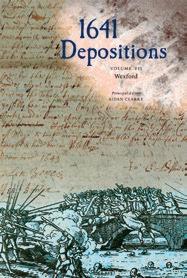
príomh-eagarthóir Aidan Clarke
Cé go bhfuil c. 140 teistíocht san imleabhar seo, i gcás fhormhór na gcáipéisí do Loch Garman is cáipéisí iad a tháinig slán (ní mórán iad) ó shaothar ceann de na ‘Coimisiúin na Ciontóireachta’ a ceapadh i ngach ceantar i mí na Samhna 1653 nuair a bhíothas ag ullmhú do chur i bhfeidhm Acht an tSocraithe 1652. Mar sin, is cáipéisí fíorthábhachtacha iad a chuireann lenár dtuiscint ar chúrsaí úinéireachta talún in Éirinn an 17ú haois. Tá taifead an-sonrach i dteistíochtaí Loch Garman, níos mó ná contaetha eile, ar an gcaoi ar réitigh daoine iad féin le dul i mbun cogaidh, ar thóg siad agus ar thacaigh siad le fir troda agus freisin ar an gcaoi ar an tionchar a bhí ag smacht níos leithne polaitiúil ar an gcontae.
ISBN 978-1-906865-41-2, lxx + 533pp, €50



Nelson of course also departed O'Connell Street in 1966 but not of his own volition. The Spire of Dublin has eloquently replaced him, completed in 2003. Ann Summers, lingerie and sex toy shop closed after 15 years in O'Connell Street, but only to relocate in Henry street. Remember back in 1991, days when a glimpse of stocking in Cleary's window was something shocking, the furore caused by the announcement that Ann Summers shop from pagan colonial Britain planned to open across the street from our hallowed GPO, of all places. Ann Summers chief executive Jacqueline Gold ominously received a bullet in the post. More politely the Dublin City Centre Traders’ Association called the planned shop 'inappropriate' for the location. Success on our main thoroughfare meant they also opened in Blanchardstown, Cork and Belfast.
Last year a new Garda station opened near the Savoy cinema and began operations to tackle anti-social
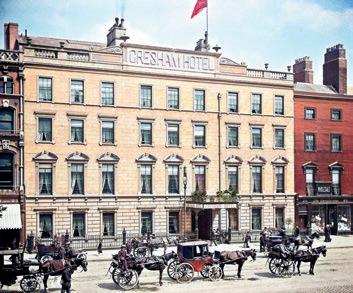

behaviour, drug use and dealing. But it's not just law and order. The rundown nature of business, work and opportunity in the entire Dublin 1 area is the real problem.
Some small rays of hope are showing.
Just before Christmas I made a rare visit in recent times to O'Connell Street to buy some gifts at Easons. All busy, crowded and happy. I enjoyed a wander up and down Dublin's main street. Gifts happily bagged I safely arrived back to Abbey Street and my bus home. But I choose to visit by day. At night it might be a more daunting place. But this is not new. All my entire working life this northsider spent working in either Dublin 2 or 4. Social commutes would inevitably be the same. Dublin1 and O’Connell Street would be visited on occasions, maybe cinema, some shopping in Arnotts, Gate Theatre or Chapter One, if invited.
The Gresham Hotel (now the Hotel Riu Plaza The Gresham) on O’Connell Street since 1817 was once regarded, along with


the Shelbourne on St.Stephen’s Green, as Dublin's two posh 5 star hotels. The Gresham had all the famous, British Royalty, US Presidents, famous stars of stage and screen. Dwight Eisenhower stayed here and , Bing Crosby, Grace Kelly and Prince Rainier, James Stewart, John Wayne, The Beatles, Laurel & Hardy, Louis Armstrong, Ella Fitzgerald, Richard Burton and his wife Elizabeth Taylor (an account of that long visit is in Dublin Dossier Mar./Apr. 2021)
During the Civil War in 1922 Cathal Brugha and Countess Markievicz were there, not exactly guests. They were commanding Anti-treaty forces occupying the hotel, subsequently after repeated battering that caused the hotel to be destroyed by fire on 6th July 1922. Later, awarded £93,550 compensation by the Irish State,reconstruction began in 1925. The new Gresham, designed by Robert Atkinson, famed for his Art Deco styling, was reborn with the facade of striking grandeur still with us today.

























Leave behind a little magic! Let your legacy bring magic to the lives of children living with serious illness. A gift in your will whether it is a large or small sum, or a percentage of your estate will make a lasting di erence.



Barretstown o ers free speci cally designed camps and programmes for sick children and their families. When looking after your loved ones in your will you can also transform the lives of sick children for generations to come.
We can help you succeed in making this gift.




For more information, please contact Clare Martin on 045 864 115, email clare.martin@barretstown.org or ll out this slip and return by post to the address below.
Yes, please send me a free brochure
Name:
Address:



Your care and compassion for others can live on through a legacy gift. By remembering Barretstown in your will you can make sure that every child with serious illness can experience the magic of camp.




County: Eircode:



Healing doesn’t just happen in hospitals and laughter may very well be the best medicine.

Barretstown Founder, Paul Newman

Registered Charity Number: 20027759




During the Second World War the hotel achieved an unexpected boost when the Daily Express in Britain ran a front page piece to show how neutral Ireland was not suffering from the effects of war and illustrated it pictures of the Gresham's extensive à la carte menus, unintentionally increasing the numbers of off-duty servicemen visiting the Gresham. U.S. First Lady Eleanor Roosevelt even dropped in unexpectedly accompanied by ten U.S. airmen.
The Gresham is currently trading as a 4 Star - there's only one 5-star in Dublin 1 - The Morrison Dublin, Curio Collection by Hilton on Ormond Quay Lower. Remarkably the man that founded and opened the Gresham Hotel started life as a foundling baby abandoned on the steps of the Royal Exchange in London. His parentage unknown, he was named Thomas Gresham after Sir Thomas Gresham the Elder, the English merchant and financier who acting on behalf of King Edward VI, Queens Mary I, Elizabeth I, founded the Royal Exchange in the City of London in 1565.
Somehow Thomas came to Dublin, we don't know why or when. He was employed by William Beauman in Rutland Square (now Parnell Square) as a servant and later butler. Somehow by 1817, Thomas managed to lease 21 and 22 Sackville Street (now O’Connell Street) and opened a hotel. In the following years he leased more adjacent buildings. By 1834 Thomas was also the owner of
the Royal Marine Hotel in Kingstown (now Dun Laoghaire). How he acquired his capital is unknown.
Thomas became a northsider, living in Seafield House, Dollymount, Clontarf. There he also built a row of houses called Gresham Villas on Clontarf Road. In 1835 he moved even closer to my future abode, leasing the lands around Fox House on the Howth Road Raheny and he lived there until he died in 1871. That land today is Raheny Park. In death he became a southsider in Mount Jerome Cemetery.
Another major asset for Dubin 1 is the two Michelin star Chapter One restaurant at 18-19 Parnell Square. www. chapteronerestaurant.com Gwendel Poulenc, the international

director of the Michelin Guide only last year forecast they might be ‘joining the family of three-star restaurants’. There are none so far in Ireland.
The other two star Dublin restaurants are on the southside, Restaurant Patrick Guilbaud in The Merrion Hotel, 21 Merrion Street Upper, Dublin 2. and Liath Restaurant, 19A Main St, Blackrock.
The new Garda station near the Savoy cinema and the announcement that Operations Spire and Citizen would begin to tackle anti-social behaviour, drug use and dealing are postive developments that are broadly welcomed. Some small rays of hope are showing or
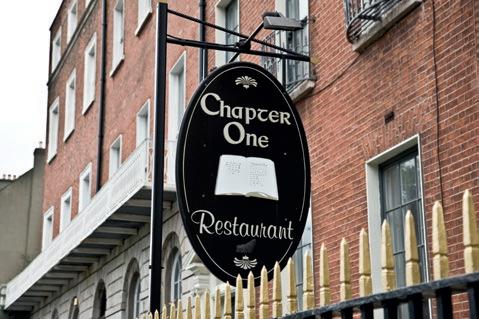

As my husband is a native (hailing from Torc, near Muckross House), Killarney is no stranger to us. We have many happy memories of holidaying there over the years, especially when our children were small. We introduced them to the delights of Torc Waterfall, Lady’s View and on further towards Sneem, where the stars at night can be truly enjoyed without any interference from other forms of lighting. Not to mention long idle afternoons fishing by the middle lake (near Muckross) and later, towards evening, into Killarney itself, where Bird’s Bazaar and its hurdy gurdies provided the evening’s entertainment. Thrills and chills galore on merri-go-rounds and chair-o-planes.

Now that the children are grown men and women, my husband and I still go to Killarney…they also go regularly, having only happy memories of the place. On this occasion, as on many others, knowing that I walked in the footsteps of some famous Romantic poets lent an added frisson. Percy Bysshe Shelley (Ode to the West Wind, To a Skylark) visited this popular southern town in 1813. Borrowing from his poem Ozymandias, ‘I met a traveller from an antique land’, indeed, we met many travellers over the course of a three day get away break.
Shelley’s poetry sang in my heart as I traversed the town with purpose. I fancied I was seeing it through his ‘romantic’, literary eyes. Writing from Italy in 1818, Shelley described Lake Como as exceeding ‘anything I ever beheld in beauty, with the exception of the arbutus islands of Killarney’. Conversely, Wordsworth visited there in 1829 (no doubt with sister Dorothea in tow), finding fault with ‘the heavy shape of the highest hill, Mangerton’. Wordsworth climbed the mountain at the grand old age of 59. Tennyson’s poem The Splendour Falls was inspired
by Killarney’s Ross Castle and Lough Leane. One of my own poems Margaret Atwood’s Hair is inspired by a Yew tree at Muckross Abbey. It’s spiralling upwards tendrils brought the award winning writer to mind as I’d read an article about her in that particular week’s Sunday Times. The accompanying photograph of her showed a striking hairstyle in ‘yew’ tree fashion.
Despite our advancing age, visiting Killarney in spring while celebrating my husband’s 70th birthday, proved illuminating and energising. It’s always that little bit milder there and despite drizzling rain, a great number of travellers thronged the town. Traditional music poured out from public houses in the evening and dining establishments appeared full. Sounds of merriment filtered onto the street and aside from the locals or those from neighbouring towns, a goodly number of international tourists swelled the crowds.
First things first. We stayed at four star The Dromhall Hotel, conveniently located 5 minutes from the town (within comfortable walking distance). The establishment itself is pristine. Spotlessly clean and tastefully decorated. The impressive staircase to the upper floors
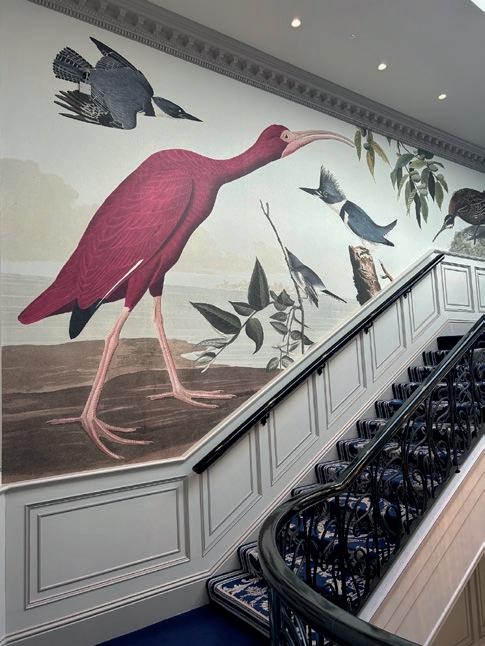
(there’s also a lift) boasts beautiful wallpaper, showing large images of Audubon’s Birds of America. Audubon’s Blue Heron and Pink Flamingo feature, a feast for the eye. The lobby itself is reminiscent of the Art Deco period, soothing the senses and providing a welcoming atmosphere. Our room was lovely, having all the required facilities. There’s also a spa and pool facility nearby the main building. Where The Dromhall excels however, is in the culinary department. We ate every evening in the restaurant, delighting in fine food, well presented and utterly delicious. Breakfast is great value. Full Irish and varied buffet for €15 in this day and age is tremendous value by any standards. For the food alone, I can recommend the hotel. It’s worthwhile keeping an eye on prices via various websites. We were there on a bank holiday weekend so that was reflected in the cost. But there are good deals to be had at different times of the year.
Killarney, as well as being popular with the rest of the country, is a regular hotspot for visiting celebrities. Former Manchester United forward Dwight Yorke, Hollywood A Lister Peter Gallagher (star of the ‘The OC’
and blockbusters such as ‘Sex, Lies and Videotapes,’ ‘While You Were Sleeping’ and ‘American Beauty’ to name but a few). Queen Victoria came to Muckross House in 1861, boosting the social standing of the incumbent Herbert Family. This was Victoria’s first visit to Killarney, although she’d previously visited Ireland in 1849 and 1853. The Queen was accompanied by Albert, the Prince Consort, the Prince of Wales, Prince Alfred, Princess Alice and Princess Helena. Which brings me to Killarney House, a wonderful exhibition space also within walking distance from our hotel. In all our visits to Killarney, we hadn’t noticed its existence. Shock and horror. Previously owned by The Earl of Kenmare, when the Queen was hosted there (Monday, 26th August), the visit was regarded as a State event whereas Muckross House was private. Kerry’s Evening Post, Wednesday reported that Her Majesty ‘had declared her intention of being very quiet while at Muckross.’ But as the saying goes, ‘the cat can look at the Queen’ and we pretty much followed Victoria’s itinerary, visiting Torc Waterfall, Muckross House and Ross Castle. However, we didn’t embark at Muckross boathouse for Tomies to view a stag hunt upon the lake,


nor were we met with a troop of Royal Dragoons or accompanied by a Viscount or two. Still, we felt very welcomed and appreciated wherever we went.
Unfortunately, the declining fortunes of The Herbert family subsequent to Victoria’s departure, can be traced to that visit. Tapestries, mirrors, Persian carpets, silverware, musical instruments, linen, china and servants’ uniforms were all commissioned for the occasion. The curtains, which still hang in the dining room of Muckross House, were specially woven, probably in Paris. In return for such largesse, before departing Muckross, Victoria gifted Mrs Mary Herbert with a bracelet of gold, pearls and diamonds. Mary’s daughters Eleanor and Blanche also received a piece of jewellery. The Royal Collections at Windsor Castle contains three water colours by Mary Herbert. It’s presumed these were presented to the Queen on her departure. The Herberts alas didn’t receive the titles they’d hoped for.



Victorian botanists flocked to Killarney also. The birth of the industrial age allowed those wealthy enough to pursue more intellectual pursuits, a new appreciation of nature. The beauty and diversity of different landscapes surrounding Killarney attracted collectors from Britain and Europe. The lush habitats around the lakes offered the prospect of new finds. They also came in search of “Killarney Fern” (Trichomanes speciosum). The fern is known to have a mythical status among Irish and British botanists. However, due to its ethereal beauty, it has an unfortunate history of being over-collected. It’s now protected by EU law. The location of any sites are top secret and preciously guarded. Speaking of closely guarded secrets, Killarney house, for us, has been one of the best kept secrets in Killarney. How had we not come across it before? Perhaps because we tend to stray towards Muckross House and Muckross Abbey rather than towards the town and its environs? In any case, it’s a treasure, filled with interactive exhibitions of the area, gorgeous photography. The website claims that the “ ‘Golden Gates’ that stand guard at the entrance form a portal to the wonders of the National Park beyond. As you pass through these (black!) gates, the sounds of the town fade away and the magic of the Park begins to wash over you with each step you take.”
Mystery solved. Killarney House & Gardens lay hidden behind high walls for decades. The grounds were accessible but the house itself lay neglected. The history of Killarney House seems complex and long. Home to the Earls of Kenmare, it was built in the early 18th century. Known locally as ‘The Mansion’ it was considered one of the finest examples of its kind in Ireland. However, the house fell prey to fire in 1913 and all that remains of it today are the stepped gardens and some of the original gate
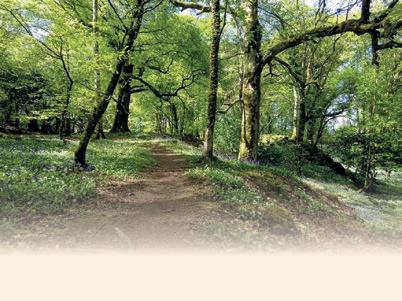
lodges. Knockreer House now fills the site of the original ‘Killarney House’ from where elevated views of Lough Leane and the McGillycuddy Reeks can be enjoyed. The much loved Cherry Walk had been a popular pathway to the Knockreer area of the National Park. The website ponders how the obscurity with which the house and gardens descended to were difficult to understand, given proximity to the town. But following extensive renovations in 2016, Killarney House and Gardens is literally open for business… free of charge! The exhibition space in Killarney House is available from 9am to 6pm and from April to September, guided tours take place every 30 minutes. The exhibition space is a gateway to the treasures of the National Park and reveal flora and fauna histories and the efforts made to preserve and nurture. There are also narratives on show which both intrigue and charm. The story of local legends for example. One such tells that O’Sullivan’s waterfall once ran with whiskey instead of water! The Chieftan of the Fianna, Fionn McCumhal, lived on Tomies Mountain above the cascade. His personal supply of whiskey flowed down to the cascade below. The local lord, O’Sullivan of Tomies, who owned the land around the cascade was lucky enough to share Fionn’s whiskey. But when the English invaded Ireland, the whiskey changed to water and became known as O’Sullivan’s Cascade,(Killarney House & Gardens)
Killarney has been described as a ‘district unmatched in Europe for its richness in bryophytes and because of this, enthusiasts come from all over the world. Bryophytes are mosses, liverworts and hornworts. They play an important role in regulating ecosystems for other plants which live alongside and benefit from the water and nutrients that bryophytes collect. Unfortunately, today, invasive species such as rhododendron (‘rodos’) and the Sika deer are the main
threat to these plants. As they travelled the world, Victorian explorers brought back new exotic plants and animals from Asia, Africa and South America that delighted the public but also created these new threats. Plants such as camellias, lupins, orchids, caught the imagination of the public and added to the prestige of wealthy property owners but alas, the rhododendron proved to be one of the greatest ‘scourges’ in terms of eradication. Numerous schemes are ongoing to rid the landscape of their presence.
What I personally found so wonderful about Killarney House exhibition space is how vibrant the landscape appears and how much care has gone into presenting forests and lakes and all that lies between, in the best possible light. I’ve always thought the woods around Torc (where my husband was born) are just magical. Trees, old as time, continue to thrive. Lush greenery, varying shades of green, all contribute to an other worldly atmosphere. We’ve never taken them for granted. But to look at the in-depth representations in Killarney House has meant falling in love with these trees all over again. It’s a true learning experience and also humbling. Killarney’s National Park is such a treasure that a whole episode of David Attenborough’s ‘Wild Isles’ focused in on the wild life and truly magnificent scenery that can be enjoyed on the 26,000 acres. Hopefully, we will be returning to Killarney for many years to come.
Killarney History and Heritage (Collins Press) by Mike O’Sullivan, which features visiting Romantics in detail is well worth a read.
infokillarneyhouse@housing.gov.ie for further details concerning Killarney House.
Photographs of Killarney National Park
Listowel Writers' Week 2024 is just around the corner, and we're thrilled to invite you to join us from May 29th to June 2nd for an unforgettable celebration of words, wisdom, and wonder

Midway to the Marvel:
As we find ourselves at the mid-way point to the literary festival that is Listowel Writers' Week 2024, the energy is electric, and the anticipation is building for an unforgettable celebration of the written word. We are on the verge of presenting our program at a glance, a curated glimpse into the literary feast that awaits, promising a tapestry of diverse voices, ideas, and creativity.

Our competitions continue to be a testament to the rich tapestry of storytelling. The Kerry Group competition has seen a kaleidoscope of entries, each reflecting a unique perspective on the human experience. The Pigott Poetry Prize, a celebration of poetic prowess, has welcomed submissions spanning traditional sonnets to avant-garde verses, showcasing the dynamic nature of contemporary poetry. The Byran McMahon Short Story Award has become a canvas for compelling narratives, delving into the intricacies of life, love, and everything in between. Meanwhile, our Poetry Collections competition has accumulated a treasure trove of lyrical expressions, demonstrating the breadth and depth of poetic exploration.


For those yet to contribute their literary gems, our remaining competitions beckon you until the 8th of March. The Single Poem competition invites poets to distill their essence into a singular masterpiece, while the Creative Writing Competition welcomes narratives that push the boundaries of imagination. The Nilsson Heritage Award, a tribute to cultural preservation, awaits submissions that delve into the rich tapestry of history. Young minds are encouraged to participate in the Children's Competitions, offering a platform for budding wordsmiths to showcase their creativity. For detailed guidelines and submission information, visit our website at www.writersweek.ie and be part of this literary journey.
In the coming weeks, we eagerly anticipate the launch of our program at a glance—a tantalizing preview of the literary wonders that await you. Brace yourselves for a lineup that will spark your imagination and inspire your literary soul. Stay tuned for this literary revelation as we prepare to unveil the magic that Listowel Writers' Week 2024 has in store.



Celebrating 50 Years with Kerry Group:
This year is not just another edition; it's a milestone celebration. We celebrate 50 years of collaboration with the Kerry Group, whose steadfast support has played a pivotal role in shaping Listowel Writers' Week into the literary extravaganza it is today. We express our gratitude for their enduring commitment to the arts and the fostering of creativity.

Embark on the Literary Extravaganza:
Get ready to immerse yourself in a literary journey like never before! From May 29th to June 2nd, Listowel Writers' Week will be a feast for the mind, an opportunity to meet literary masters, discover emerging voices, and unleash your creativity. Exclusive surprises await, promising moments that will make this edition truly extraordinary. Mark your calendars, stay tuned to our socials, or visit www.writersweek.ie for the latest updates.
Mark your calendars, set your reminders, and get ready for a week that promises to be a literary extravaganza. Join us at Listowel Writers' Week 2024, where words come to life, friendships are forged, and creativity knows no bounds. Keep a close eye on our socials or find us on www.listowelwritersweek.ie

























The book discusses the historical development of Dublin and the maps associated with it.
Birlinn, a leading publisher of city mapping books has published Dublin: Mapping the City. This highly anticipated book offers readers a captivating exploration of Dublin's rich history and development through the lens of carefully curated maps, illustrations, and informative narratives. With over 30,000 copies sold in their acclaimed series of mapping the city books, Birlinn continues its tradition of delivering high-quality and engaging content to map enthusiasts, history buffs, and Dublin lovers alike. Dublin: Mapping the City showcases the expertise of the authors, who have dedicated years to researching and curating Dublin's maps, making this book an invaluable resource for those interested in the city's vibrant past.
Featuring approximately 60 main maps alongside a wealth of other illustrative materials, including photographs and engravings, the book provides a visually stunning experience



for readers. Each map tells a story, capturing significant moments and transformations in Dublin's history, from the seventeenth century to the present day.
While the maps highlight major events like the restoration of the monarchy in 1660 or the impact of the Easter Rising in 1916 and the Civil War in 1922, they also delve into smaller, yet equally fascinating, tales. Readers will discover the establishment of an Irish-speaking colony in the late 1920s and how the introduction of parking meters revolutionized the use of Dublin's city centre. The book goes beyond architecture and landmarks to encompass transportation, health, trade, daily life, and work, offering fresh perspectives on one of Europe's great cities.
Dublin: Mapping the City is a large format, high quality extremely attractive hardcover publication, readers will also find an introduction that delves into Dublin's origins, tracing its Viking roots and the historical debates surrounding earlier settlements. From there, the book takes readers on a captivating journey through Dublin's evolving landscape, guided by the meticulously researched maps and engaging commentary provided by the authors.
Dublin: Mapping the City is not only a comprehensive exploration of Dublin's history but also a testament to the power of maps as storytelling tools. It captures the essence of a city that has experienced remarkable growth and change over the centuries, offering readers a unique perspective on Dublin's past and present.
About the authors
Joseph (Joe) Brady taught in the School of Geography at University College Dublin. He has been writing about the development of Dublin for many years and is one of the leading experts in the field.
Paul Ferguson is Map Librarian at Trinity College Library, Dublin.

Dublin: Mapping the CityA Fascinating Journey Through Dublin's History and Evolution is published by Birlinn at €30










We all tend to eat and drink hearty and warming food and wine in the winter months, and then as the days grow longer and brighter, we turn to lighter fare.
This is true for both white and red wines, and indeed for rose and sparkling wines also. It is helpful to know a little about the wines themselves, before deciding what you might like to try for the changing seasons. Of course the alcohol content is a major factor, and while some wines have been coming on the market at 15per cent in the last few years, this can in part be due to
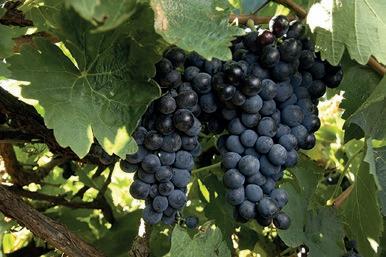
global warming and not market driven. Wines of this strength are boarding on the fortified wines, like sherry and port, and certainly not suitable as a lighter seasonal option. Traditionally,






wines were usually presented at 12% or 12.5%, but over the past number of years, this has been creeping up. So do check the alcohol percentage at the back of the bottle, if you want to lighten up.
The next question is should you opt for red or white wine – and do you know the processes that differentiate the making Now you don’t have to be a master of wine to host an evening of wine tasting with your friends, and I have often been asked to give a few pointers to people who would like to organize one. So here are some basic guidelines for getting started. First of all choose a theme, it could be wines from several different producers in a particular region, or a specific grape variety made in different regions around the world. Because we are looking at lighter wines for springtime, you could ask your guests – perhaps about eight people – to bring a bottle that fits with your chosen theme. For example ask them to bring a wine – either red or white – that is 12% alcohol or less. What we are looking for here is a wine with lots of taste and character and a lower alcohol content. Then you decide if you want to serve the wines “blind” – this is where the bottles are wrapped in paper and so the focus is on the wine itself, not on the brand, price or reputation. Provide everybody with pen and paper and let them guess where the wine comes from and give it points out of five. You can then reveal the wines, discuss each person’s remarks and chat in more detail about what everybody thought of each wine. You can then taste again and see if people’s opinions change. I can guarantee a very sociable evening will be enjoyed by all, but don’t forget to provide some food. Crackers and cheese or some cold meats – I love Serrano Ham for its saltiness – and it goes very well with some crusty bread. It is important to offer plenty of nibbles, especially towards the end of the evening, to soak up the wine!


Organizing a spring wine tasting with friends is a great way to welcome in the new season, and you can take it in turns to host the event, making it an annual get-together. You can also have one in September, this time tasting warmer wines for the winter months. It is interesting to see how people’s tastes change and grow, and of course it is always great to taste new wine and not keep to the same ones – even though they might be your favourites!
And finally, you could restrict your spring tasting to white wines only, and your winter tasting to reds. However you might like to include some rose wine – which is becoming ever increasingly popular – and this would certainly belong to the spring tasting. Ideal for summer al fresco dining, rose is more popular than ever now, and thankfully there are some great rose wines available now that are not overly sweet and accompany foods very well.
With Springtime being a time of new beginnings, it is the perfect time to add to your wine appreciation experience.
Money is flooding into professional golf these days. On top of the tens of millions which Saudi Arabia are prepared to offer individual, leading players, there has been the announcement of a huge, corporate windfall aimed at the game’s administrators in the United States.
It was learned during the build-up to the Pebble Beach Pro-Am in early February that Strategic Sports Group, a consortium of professional sports owners, was set to make an initial investment of $1.5 billion in America’s PGA Tour Enterprises, with another $1.5 billion potentially on the way. We were further informed that the consortium, led by Fenway Sports Group, were also planning an active role in plotting strategy for the tour on and off the golf course.
All of which had me wondering what the game’s great deal-maker would have made of it all. I’m thinking of Mark McCormack who made a fortune by representing the business interests of leading players over the years and even saw fit to represent the Pope.
I’ve a feeling he would see the current situation as an agent’s heaven on earth. McCormack was responsible for inventing percentages, as in the extent to which an agent might expect compensation from his client. According to American scribe, Alan Shipnuck, ‘the standard arrangement in professional golf is that players keep all of the money they win on the course, but agents take 20 percent of appearance fees and endorsement deals. LIV’s upfront money is treated like the latter, and as a result, the player representatives are getting a fat pay-off. [Because there is no cut in LIV events and players are guaranteed a cheque, some agencies are


taking a commission on the first $120,000 of a player’s winnings, treating it as a de facto appearance fee.] One veteran caddie to a top player who has remained loyal to the PGA Tour says in a text message, ‘I honestly think that one of the backstories to this LIV thing are agents who desperately want the biggest payday of their lives.’
In sharp comparison, Rory McIlroy operates on a very different level. Effectively, he’s in a position to call his own tune, when it comes to lucrative business deals. As a member of his management team once pointed out to me: ‘The key difference in looking after Rory’s interests is in the telephone traffic. With him, the calls are all incoming. You don’t need to chase deals; they come to you.’
That’s the sort of power which prompted Tiger Woods to break with McCormack’s International Management Group (IMG), within a few years of becoming established on tour. Instead, he turned to a trusted lieutenant, Mark Steinberg and his relatively small operation, Excel Sports Management, to look after existing deals.


I first learned about this sort of business when I went to work in Fleet Street during the 1960s, having started in sports journalism in the Irish Press Group in Burgh Quay, Dublin. In the aftermath of World War II, Denis Compton of Middlesex, Arsenal and England happened to offer a lift to a sports enthusiast with a name borrowed from Irish history. That journey through suburban London led to Bagenal Harvey becoming the first professional sports agent in these islands.
When I met Harvey some years later, he expressed pride in his Irish heritage and explained his relationship with one of the greatest sportsmen of his time. It began with Compton giving him permission to sift through an incredible mound of mail on the back seat of the car.
There were letters offering lucrative endorsement contracts and others, written some time later, cancelling the offer in the absence of any response. The pile represented a fortune in potential earnings, which Compton had been too busy to handle.








When Harvey offered to become his agent, Compton agreed. Soon afterwards the sleeked black hair of a cricketing icon who would win an FA Cup medal with Arsenal, was to be seen in newspapers and magazines throughout the land, advertising Brylcreem. Sport had acquired a new, business dimension which was about to bring untold wealth to its professional participants.
Interestingly, a further Irish connection to this agent’s story can be linked to McCormack, whose grandfather hailed from Abbeyfeale. And the American’s upfront philosophy was governed by the first principle of successful trading – supply and demand. It led to some extraordinary deals, including the marketing of the visit by Pope John Paul II to Britain in 1982.
When I interviewed McCormack in St Andrews in 1990, his place in sports management had been firmly established with such clients as Arnold Palmer, at that time the biggest earner in the history of sport, along with Greg Norman, Nick Faldo, Jackie Stewart and Alain Prost. As a simple rule of thumb, he took 10 per cent of a sportsperson’s competitive earnings and 25 per cent of their commercial income, in other words, everything he generated for them.
McCormack told me: ‘My approach at the start was basically very simple: I tried out the market for as much as I could get. Then I thought maybe I could get a little bit more. Obviously a manufacturer is not going to pay £100,000 for Nick Faldo if he doesn’t believe he’s going to get that money back in value.’ Effectively, his credo became: you keep asking for more until somebody says stop.
In his early years as a graduate of Yale University Law School, McCormack took up a position at a Cleveland law firm and, as a sideline, began arranging exhibitions for his golfer friends while offering them legal advice on a casual basis. ‘It is ridiculous now to look back to 1960 and see nobody was doing this sort of thing,’ he said (I didn’t have the nerve to tell him about Bagenal Harvey). ‘Nobody was representing anybody, with the result that sportsmen’s activities were not being commercialised. I tried it and it worked.’
He then talked about appearance money, which was an important factor in players’ activities right back to the 1960s. ‘Appearance money is a complicated problem for the simple reason that there are many ways of disguising it,’ he said. ‘It is paid on the US Tour all the time, but under a different guise. For instance, a player will be asked to play in an outing before or after a specific tournament for a fee of say $25,000 and, incidentally, we would like you to play in our tournament. That, theoretically is payment to play in the outing but in practice is it actually appearance money.
‘If the sponsors of the world start thinking that golf is no longer a good investment and the spectators stop coming, then all payments will go down. So far, however, all these things are going up. And I don’t have any problem with that.’
And who could have blamed him, though his percentage still rankled with many rank and file golfers. I remember Eamonn Darcy as one of this country’s more successful practitioners putting
the situation into perspective when he said: ‘The way my career is going right now, I’m happy to handle my own affairs. But if I happened to win the Open Championship, the first call I would make would be to McCormack.’ This was Darcy’s way of acknowledging the dealmaker’s negotiating power.
It is part of golfing lore how McCormack built his business on the so-called Big Three of Arnold Palmer, Jack Nicklaus and Gary Player. This later became two when Nicklaus parted company with IMG because he felt McCormack’s main attention was being focused on Palmer, even though the Bear was the best player in the world.
Meanwhile, it is fascinating at this remove to note McCormack’s views on the future of sport, as he perceived it 34 years ago. He talked about Rugby Union expanding and becoming more commercial as a result of the arrival of the World Cup. Then he said: ‘South Africa will be reopened to international sport once more; we will have more electronic coverage from one continent to another and more interest in the internationalisation of sport. There will be more leisure time through automation.’
He further predicted that former Eastern Bloc countries would be too preoccupied about jobs and building houses for their citizens to give priority to sport.
When McCormack died aged 72 in May 2003, his estimated wealth was put at $1 billion. In the current climate, he would have little difficulty in doubling that figure.

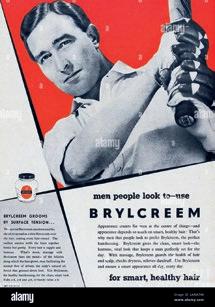

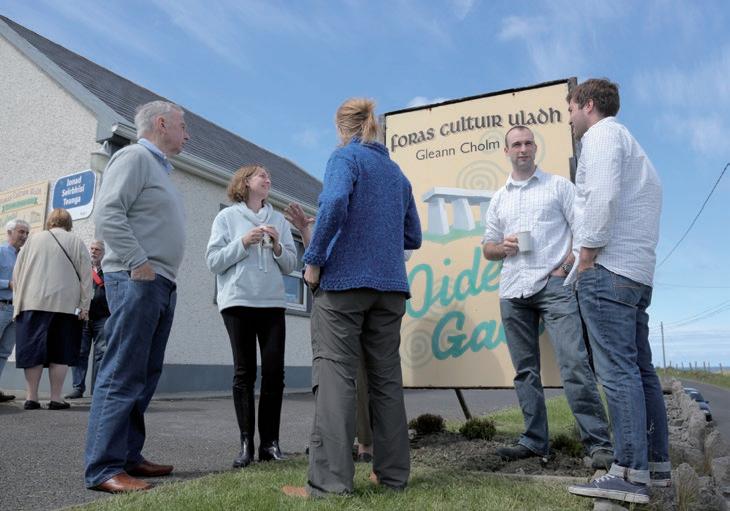
Irish Language courses for all levels, Hill Walking, Archaeology, Environment, Folklore, Geology, Painting, Weaving, Singing, Translation, Flute & Tin Whistle, Irish Harp…


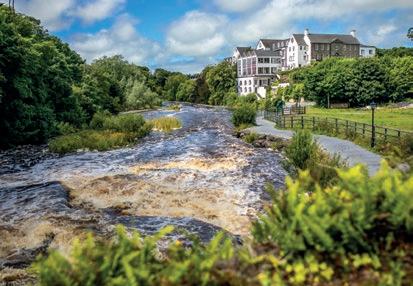

‘I think the most important thing in a democracy is the library,’ says Theo Dorgan, chatting to me in Cork City Library on the occasion of the launch of his poetry collection Once Was a Boy, the ‘One City, One Book’ for 2024.
Growing up, he visited the library twice a week to borrow history books, sci-fi, thrillers and ‘Mills and Swoon’ books (as he jokingly puts it) ‘For the ma.’ Theo was also a fan of the Biggles and Just William books. He was ‘drunk on words.’
His father, who worked in Dunlops for thirty-two years, had a subscription to the Companion Book Club. ‘There were all sorts of mad things at home like books on the first iteration of the SAS (Special Air Service) during the second world war. There was a book on Everest by Edmund Hillary. I was reading everything. I used to get a pineapple bar every Wednesday to read comics to a boy whose auntie Sheila used to buy them for him.’




To mark the publication of his latest poetry collection, Colette Sheridan talks to Theo Doran
While Theo has never kept a diary, he says he was ‘taken aback’ by how much he remembered when the poems in his latest collection started to appear on the screen and in notebooks. (He never forces poems but rather waits for them to emerge.)
At the library launch, it was clear that this son-of-Cork (who lives in Dublin but says he never left his native city, he just lives elsewhere) is much respected and loved. There was a big turnout with the Lord Mayor Cllr Kieran McCarty paying tribute to Theo. And some of Theo’s siblings were in the audience.
The boy from Redemption Road on Cork’s north side must have been a bit precocious. He promised himself that he would remember what went on as a school boy. ‘When I began to notice what was happening like kids being bullied and so on, I think I wanted to remember so I could tell their story. I learned to
read at the age of four, self-taught at the beginning and then obviously at the convent (St Vincent’s Convent).’
But the young fellow of four years of age was not at all impressed by school as described in his poem, Back Again
It reads: ‘Then we have to go back again. Monday/My dad is putting his bike into the shed./I don’t think I’ll bother going back, I say./ He sits on his heels and looks at me. Back where/he says./ School. Oh and why’s that, he asks/ Well, to be honest, it isn’t very interesting./He starts roaring laughing and so do my Mam,/Aunt Angela, Uncle John. I don’t understand/but it makes me angry and confused./’
Theo went on to the North Monastery secondary school, followed by University College Cork (UCC) where he lectured and tutored before becoming involved in the establishment of the Triskel Arts Centre where he was literature officer.



With his close friend, Mick Hannigan, Theo re-founded the Cork International Film Festival and went on to become director of Poetry Ireland. In 2000, he was elected to Aosdána and served on the Arts Council for five years. He is also an essayist, a documentary maker and has written about his sailing adventures. He came up with the idea for The Great Book of Ireland and was one of its editors.
The eldest of fifteen children (there were originally sixteen children in the family but one died at a very young age), Theo is blessed with a good memory. He points out: ‘We forget sometimes how ferociously attentive children are. We knew the teachers we could trust and the ones we couldn’t. Some of that was lore passed down from older brothers or neighbours. Also, because there was so little in our worlds, what went on got all our attention. If you’re trapped in a classroom day in, day out, you study the teacher more minutely than you do your mother or father. We are born with ferocious attentiveness.’
For Theo, writing essays in class felt like being in ‘a safe space’ with everything calm and silent. Was it otherwise unsafe? ‘You’re talking about the 50s and 60s. You never knew when you were going to get hit. A six foot man hitting an eight year old child was wrong. I’m sick of people I was at school with saying ‘it never did me any harm.’ Of course it did. I saw fellows being beaten simply because they didn’t understand something.’
Theo says he was ‘constantly’ beaten at school. Did it give him a fear of authority? ‘No, but it gave me a fear of violence. It made me very aware of situations that might turn violent.’
School made Theo unable to trust authority’ because of the injustices he witnessed. ‘I learned very early on to question authority. I became a rebel, day one. I remember going into secondary school and a brother said to me: ‘You have a bold spirit and I’ll break it before you leave this school.’ I’m looking at this guy thinking, ‘no you won’t.’ But it was going to be rough. But what doesn’t kill you makes you stronger.’
At the age of fourteen, Theo ‘just stopped’ the charade of pretending to practise religion. ‘I wasn’t going to pretend to believe in something. Apart from being dishonest with yourself, it’s kind of insulting to people who really believe. It didn’t help that I looked at these Christian Brothers who were neither Christian nor brotherly. I remember at thirteen that these guys could recite the Ten Commandments but they couldn’t remember the eight beatitudes.’ Instead of going to Sunday Mass, Theo and Mick Hannigan would buy The Sunday Times or The Observer on alternate weeks and lap up the likes of Dilys Powell, writing about cinema. ‘It was a huge education, a time when the Sunday papers were quality.’
Theo was born ‘into the paperback revolution. I could buy a Penguin classic for half a crown in Easons and the Fontana Modern Masters. It was the first iteration of the Internet.’
He is very grateful to have been a beneficiary of free education, initiated in this country by Donogh O’Malley as Fianna Fáil minister for education from 1966-1968.
‘After Todd Andrews, O’Malley was the only really independent-minded minister that this country had. My question for



any politician is ‘what are you doing for the poor and the powerless?’ That is what has defined my politics all my life.’ At fourteen, when his mother asked him what he wanted for his birthday, he requested Guerilla Warfare by Che Guevara.
Theo was twenty-one when his mother died. His father died eight years later. When asked how his parents coped financially with such a big brood, Theo says: ‘The two salvations were the children’s allowance and the credit union. My mam was one of the first people involved in setting up Blackpool credit union. That was revolutionary for the poor.’
Theo’s sister, Noreen, took over the rearing of the younger Dorgans. At the age of eighteen, Theo was ‘out of home and fending for myself. I had part time jobs working in the library at UCC, working as a postman at Christmas and summer work on the building sites.’ Theo says his beloved Dubliner wife, the poet Paula Meehan, would move to Cork in the morning. But it could be problematic for him as it would take him two hours to cross Patrick Street, what with knowing every second person and stopping for chats. ‘I love Cork ‘though. It’s the mother of my first mind,’ says Theo.
Once Was a Boy is published by Dedalus Press and is available in bookshops and on Amazon







As we journey through life, our financial security becomes increasingly important, especially as we approach retirement age. However, with the rise of sophisticated scams and fraudulent schemes, safeguarding our finances has never been more critical.
The Financial Services and Pensions Ombudsman (FSPO) is an independent, impartial, fair and free service that helps resolve complaints from consumers, including small businesses and other organisations, against financial service providers and pension providers.
Although the FSPO cannot investigate acts of fraud, because fraud is a criminal matter for An Garda Síochána, the FSPO can investigate a complaint regarding any suggested service failings of the customer’s bank in dealing with a customer who suspects fraud on their account, and any complaint about disputed transactions.
The FSPO is aware of an increase in the number of people who are falling victim to financial scams. This highlights the need for heightened vigilance amongst customers, because any one of us can fall for these sophisticated tricks. All it takes is a moment when you are caught off guard. “Phishing” is when fraudsters, masquerading as trusted contacts, trick the customer into revealing their account security details. This can result in the transfer of funds and may lead to a complaint to the FSPO, if the customer believes that their bank has not acted quickly enough or has not dealt with the issue appropriately.
Marie was one such customer. She was the victim of a scam by fraudsters claiming to be from the Department of Social Protection, and An Garda Síochána. Marie was informed by the fraudsters that someone had stolen her identity, and that this person was suspected of money laundering. Marie was understandably very worried, and she was persuaded by the fraudsters to move her money out of the account to “protect” it.
She transferred €17,000 to a foreign bank account before she realised it was a scam. Marie’s complaint against the bank was that it had given her poor customer service and she felt let down by what she described as the bank’s inadequate complaints handling. During mediation, the bank took the view that it could have done better when Marie initially made contact, and to redress its failure in customer service to her, rather than for any error it made, the bank agreed to settle the complaint by paying Marie €4,000 in compensation.
Another common tactic used by fraudsters is investment fraud, where individuals are lured into investing in seemingly lucrative opportunities that promise high returns.
One banking customer, Joe, was defrauded of €2,250 when he decided to invest in what he believed to be a bitcoin opportunity, but in fact he chose a fraudulent company to invest his money for him. He allowed it to take control of his computer and each time he decided it was time to withdraw the money he invested, the fraudulent company told him he would need to lodge more money to release his funds. As the bank could not recall Joe’s money, he made a complaint to the FSPO. The bank ultimately settled his complaint by making a payment of €1,000 to Joe, to recognise that it had not acted swiftly, when Joe mentioned that he had allowed someone else to take control of his bank account.
The Banking and Payments Federation Ireland (BPFI) have created a very helpful website called fraudsmart.ie, which provides advice on recognising and avoiding financial scams.
By learning from the experiences of others and remaining vigilant and informed about the types of scams and frauds that are active, we can protect ourselves from harm.
If you have an issue with your bank/ financial provider, it is important that

The Financial Services and Pensions Ombudsman (FSPO) offers some practical tips for protecting yourself from falling victim to scams.
you complain directly to it first and give it an opportunity to resolve the issue. If you are not happy with the outcome of your complaint and your complaint relates to the conduct of the financial service provider, you can then complain to the FSPO.
You can find more information on the FSPO on its website www.fspo.ie
Here are some practical tips it provides for protecting yourself from falling victim to scams.
1. Be cautious about emails claiming outrageous offers or ads offering miracle products – Generally if it sounds too good to be true, it probably is.
2. Protect your personal information. Never disclose banking details or personal information in response to an email, phone call or letter claiming to be from your bank or other financial institution. Your bank will never email asking you to divulge such information as your full PIN or passwords. If you are unsure if an email is genuine, contact your bank immediately via other means.
3. Pay attention to your own instincts – If you have any doubts about giving out your card details, end the transaction and purchase your goods elsewhere.Your best defence is to stay informed, alert, and secure.
4. Keep yourself informed of the latest scams and fraud tactics, so you can recognise and avoid them.





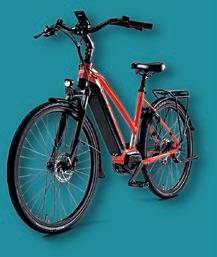








55s warned to be on high alert for investment fraud as figures show a jump of almost 26% in fraudulent scams in first half of 2023
FraudSMART warning issued following recent spike in sophisticated investment fraud using the names and branding of well-recognised banks and investment firms.
Latest figures issued from FraudSMART, the fraud awareness initiative led by Banking & Payments Federation of Ireland (BPFI), show a 25.6% jump year on year in authorised push payment (APP) fraud in the first half of 2023. Victims were conned out of a total of €8.6m euro over the same period. One of the most prevalent types of APP fraud is investment scams. FraudSMART is urging the public to be aware of highly convincing fake investment adverts and websites impersonating well known investment firms and brands.
Commenting on the recent spike, Niamh Davenport, Head of Financial Crime, FraudSMART said: ‘’In many of these investment scams, fraudsters hide behind websites, including product or investment comparison websites, which can appear to be legitimate. Consumers looking to invest, submit their details for more information and the fraudsters then call or follow up with an email, often including what looks like a highend brochure. Once the victim has authorised the payment and the money has reached the criminals account, the criminal will quickly transfer the money onwards to numerous other accounts, often abroad, where it is then cashed out.’’
Fraudsters targeting over 55s Investment scams are particularly targeted to those in the over 55 age bracket, and in the cases that FraudSMART members have seen recently, the investment amounts can start from around €5K up to many multiples of this, with some cases reaching between €50k and €600k. While the amounts may be high, victims are not necessarily wealthy customers, but often people who have worked hard to build up a pension and are looking for a last opportunity to top up their finances ahead of retirement. Other examples include consumers who have maybe come into inheritance or have used the recent increase in property prices to downsize and invest a lump sum.
Ms Davenport added: “While banks are using a range of measures to protect customers, Fraudsters are increasingly targeting consumers directly, so it’s important for us all to know how to protect ourselves. In particular, be cautious of adverts online and on social media platforms, even if they are paid or sponsored ads using familiar brand or business names. Promises of high returns on investment websites or online adverts often lead people to share personal and financial information that can be used for targeted scams. Pause for thought and contact the company independently to verify the details. If you have shared your bank details and release it is a scam, report it to your bank and Gardai as soon as possible.”

Checklist to avoid investment scams:
• Stop and think: Does this opportunity sound too good to be true? If so, it probably is.
• Take your time: It is important to note that there are very few legitimate investment opportunities that require you to hand over or transfer money immediately.
• Research thoroughly: Check the individual and firm for qualifications, credentials, reputation, and history. Central Bank Consumer Hub is a good place to start.
• Verify the information: Check all information with a trusted third party such as a legal/financial professional and consult with family and close friends.
Consumers can access a wealth of other advice on how to avoid fraud by visiting www.FraudSMART.ie and signing up for email alerts on current risks and scams as they emerge at
www.fraudsmart.ie/sign-up





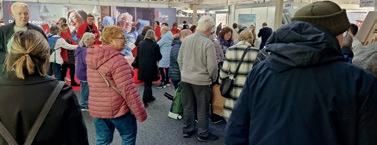
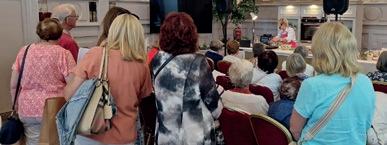
Nutella - the chocolate spread loved by children and adults alike across the world was the inspiration behind a lifesaving development in the 1990’s to treat children suffering from malnutrition.
André Briend, a French paediatric nutritionist was frustrated while working in Malawi and other famine stricken countries at the limitations of the treatments available for children suffering from malnutrition. The treatments of the time mainly consisted of a diet of milk powder mixed with oil and sugar, as well as vitamins and minerals. Although it worked well, it had to be mixed with clean water which is difficult to find in a famine-stricken country and when available, it was often contaminated during mixing.
The story goes that Briend, while having breakfast one morning, on reading the ingredient list on the back of a jar of Nutella had a light bulb moment of mixing together F100, a high-energy
milk fortified with vitamins and minerals, with peanuts, oil and sugar.
But the real advancement was in the formulation where he worked alongside a French food processor, Michel Lesanne. Together they developed a nutritious paste where the nutrients were insulated from oxygen and humidity and packaged in one dose-foil sachets. It required no mixing or refrigeration and with a taste similar to peanut butter, it was very palatable for children.
His recipe for this Ready-to-useTherapeutic Food (RUTF) was more commonly known as Plumpy’Nut® and radically changed the treatment of severe malnutrition in children.
Often mothers had to stay in health centres for long periods with their sick child for treatment, leaving behind their families. Now following an assessment at a clinic,they can return home with a supply of RUTF.
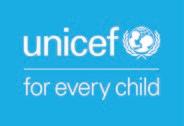

With nearly half of all deaths of children under 5 due to deficits in nutrition, RUTF has an over 90% success rate in treating children and bringing them back from the brink of death.
UNICEF is the largest supplier of Ready-to-Use Therapeutic
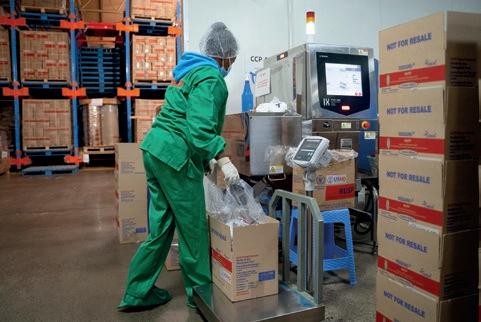
UNICEF
supplies almost 75% - 80%
With a shelf-life of up to two years,
As the lead agency for child nutrition, UNICEF works with governments and other agencies on the ground in
A Ready-to-Use Therapeutic Food (RUTF) manufacturing facility in Kenya, which can quickly distribute product at both a high quality and low-cost and also contributes to job creation in the region where approximately
99% of employees are Kenyans.
the implementation of communitybased management food programmes; supporting the training of staff, early identification of malnutrition as well as the monitoring and evaluation of child food programmes.
sister eating from a sachet of Plumpy' Nut. procures and of the world’s RUTF from its twenty or so trusted suppliers around the world. buffer stocks can be stored in the event of a humanitarian crisis or war. © UNICEF/Chad,2021/Dejongh
One such programme is in Chad where UNICEF has been working since 1961. The children of Chad are the second most vulnerable on the planet to the extremes of climate change.
Just two years ago, in mid-2022, the country was battered with two solid months of torrential rain. It caused massive damage to infrastructure and agricultural and when the two rivers that surround the capital N’Djamena burst their banks, a food and nutrition state of emergency was called.
With the war in Ukraine, there was little media coverage, but UNICEF was on the ground and funded the setting up and coordination of nutrition programmes and reached over
334,000 under-six children suffering from malnutrition. And Plumpy’Nut; this small foil packet of peanut paste which André Briend developed was used to bring children in Chad back from the brink.
And right now in northern Gaza, the situation is catastrophic where 1 in 6 children under the age of 2 are acutely malnourished. UNICEF's intervention is vital to deliver enough lifesaving supplies of RUTF so that children can be treated.
No child should die from malnutrition, no matter where they live.

UNICEF relies entirely on voluntary funding and gifts in Wills are vital to provide the funding to reach children where the need is greatest.
Legacy gifts are used to develop nutrition programmes, invest in new technologies and products as we did with Plumpy’Nut®



over twenty years ago which has helped save millions of children’s lives.
To add UNICEF to your Will our charity details are below, or call our Legacy Gifts Manager – Pauline on 01 878 3000 or learn more at unicef.ie/legacy




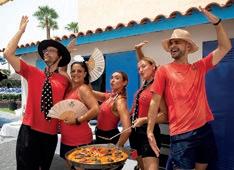

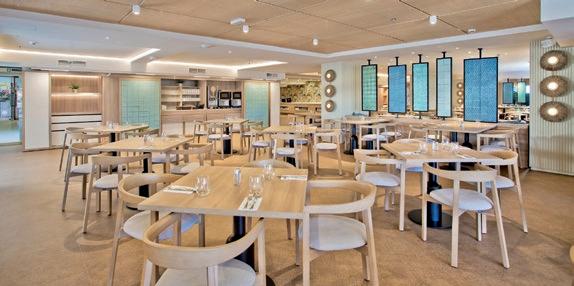
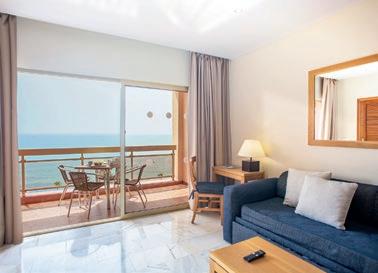









MARCH from 95€* per apt/night
MARCH from 95€* per apt/night
MARCH from 95€* per apt/night
MARCH from 95€ per apt/night





Social prescribing enables medical professionals to refer people experiencing social concerns such as loneliness, isolation and mental health issues to a range of community, local, and non-clinical programmes and services. A social prescription could include any activity that brings people together with a sense of purpose (walking groups, running groups, hiking groups, nature groups, and arts and cultural opportunities).
The global population of older people is growing faster than any other age category (1 in 6 predicted to be over 65 years by 2050 (United Nations, 2019)), and increases in loneliness, loss of connectedness, social isolation, stress and depression were identified across multiple research studies investigating the impacts of COVID-19 on older adults (TILDA, 2021). Social prescribing offers an innovative approach to addressing these issues fulfilling a growing acknowledgement of the need to consider non-biomedical approaches for healthier lives (WHO, 2020). The Health Service Executive (HSE) and Healthy Ireland (HI) launched the Social Prescribing Framework with the support of the Department of Health, which funded the HSE to support the development of community-based
health and wellbeing initiatives. The Healthy Ireland Strategic Action Plan 2021-2025, Sláintecare, and the HSE Corporate Plan 2021-2024 align with and support the development of social prescribing in Ireland. The use of arts and cultural opportunities as a means of social prescription has shown reduced costs to health services, reduced demand for health services, and increased health and wellbeing in participants of social prescribing (Polley et al., 2017). Specifically:
• 28% reduction in GP demand
• 24% reduction in visits to A&E.
• 64% drop in hospital referrals
• supports combating loneliness, isolation, depression, stress and anxiety.
• Improvement of wellbeing and quality of life
The two-year Culture on Prescription Project (COPE) offered participants a cultural opportunity to engage with arts and cultural opportunities. The project was part of a six-member
Delegation from Madam Fan Xianrui Deputy President of the Open University of China & colleagues with Madam Zhu Xikun First Secretary Education Section Embassy of China and DCU staff Christine O'Kelly & Dr. Monica Ward
Médecins Sans Frontières/ Doctors Without Borders (MSF) is an international humanitarian organisation providing medical care in more than 70 countries. From our paediatric nurses to our logisticians, we are experts at working in fast-moving and highlyinsecure environments, like Ukraine, Yemen and Gaza.
Gifts left to us in wills play a vital role in making sure we have the funds we need to deliver emergency medical care to wherever in the world it is needed.
By leaving a gift in your will to MSF, you can ensure that our financial independence – which enables us to provide medical aid where and when it is needed most –will continue.

consortium representing Ireland, Germany, The Netherlands, Belgium and Romania. Each organisation worked with an arts facilitator on a cultural opportunity (painting, sculpting, printmaking, and theatre). Evidence shows that participating in the COPE project gave participants a sense of purpose, helped them make new friends, and learn new skills.
The COPE project adopted an evidence-based approach by providing a compendium of good practices and models that can be easily adopted in parts of Europe where practical experiences with social prescribing schemes are limited or nonexistent. Some of the outputs of the project include :
• an implementation framework
• resources and support to facilitators, including a training course
• links to interactive tools
• development of a digital badge (an accreditation for an artist delivering a cultural programme)
• guidelines for decision-makers in municipalities and associations on how to implement cultural prescribing.
• A website https://culture-on-prescription.eu/
The COPE project is an example of one of the many research projects DCU Age-Friendly offers older people, in addition to a vibrant programme of educational, cultural, social, wellness and sports opportunities. A varied selection of educational modules are offered throughout the year in addition to events marking Intl Women's Day, UN Day of Older People, European Intergenerational Week, Positive Ageing Week and Bealtaine

(creative arts festival) and seminars on topical subjects such as the National Payment Strategy and Pensions Reform. The AFU unit at DCU also hosts visiting delegations from global institutions and groups to showcase the unit's work and explore collaboration opportunities.
DCU became the world's first Age-Friendly University in 2012 and is a member and former lead of a global network representing Europe, North and South America, South East Asia and Australia, which comprises over 130 universities globally.
To find out more about the DCU Age-Friendly Programme, visit our Stand 58 at the 50+ Show and chat with some of our participants.


Visit our website www.dcu.ie/agefriendly
Call us: 01 7005454
Email: afuinfo@dcu.ie
Drop in : Room AG40 Albert College, DCU , Glasnevin, Dublin 9.

















The pun, it has been said, is the lowest form of wit—just as the bun is the lowest form of wheat—and yet it is universally popular, from children’s riddles (why did the kid stick a knife in a packet of cornflakes? He wanted to be a cereal killer) to the more sophisticated wordplay of the mature.
The great Freud in his book Humour and its Relation to the Unconscious explains the pun by saying that the double meaning of a word saves us energy which is then expressed in laughter—a likely story, but that was the best that old Sigmund could come up with. But then his best attempt at a pun was to describe Christmas as the alcoholidays! Alfred Hitchcock on the other hand regarded puns as one of the highest form of art.
Quickness at making spontaneous puns is a rare gift, a great icebreaker, but one has to get in first and be prepared to be greeted with loud groans rather than laughter. And the gift must be used sparingly—I once knew a girl who made a pun on every word you said which did not endear her to everyone. And the pun is probably the only form of humour for which one has to apologise—saying ‘pardon the pun’, sometimes merely to draw attention to fact that a pun has been perpetrated in the first place. And why is a really good and clever pun invariably labelled ‘a terrible pun’?
I once entered a pun-making competition in an Irish national
newspaper and submitted ten cracking entries. I felt sure that one of them would win the substantial cash prize, but no pun in ten did. Ouch!
There follows a selection of my personal favourite puns; they may not make you laugh much, but you will find them groan on you!
Thomas Twining (1675—1741), the famous London tea merchant, once challenged a punster to make a pun on his surname. He came up with, ‘This is Twining, who would be whining if you took away his tea’.
And this is one I heard in school, many years ago:
There once was a Red Indian Chief who had three wives. At Christmas he bought the first wife a lion skin, the second wife a tiger skin and the third wife a luxurious hippopotamus skin. They all slept on their skins around him in their wigwam every night. In the fullness of time, the first wife had a baby, the second wife had twins, and the third wife had triplets. He concluded that the squaw on the hippopotamus was equal to the sum of the squaws on the other two hides. Superb!
The king’s jester was notorious for making puns and claimed he could make a pun on any subject. When challenged to make a pun on the king himself, he came back with, 'The king is not a subject’. Eventually
By Des MacHalethe jester’s puns became so outrageous that it was decided to have him hanged, but no rope could be found with which to carry out the task. The king decided to reprieve him (a suspended sentence?) if he promised never to make another bad pun as long as he lived, but the jester could not resist the temptation; ‘No noose is good noose’, he quipped, so the king had him shot.
And this very punny riddle has been attributed to our own Samuel Beckett in a rare moment of levity:
Why did the barmaid sham pain?
Because the stout porter bitter.
A quadruple pun no less from the great literary maestro!
Even treble and triple puns are rare and sometimes a bit contrived, but one has to admire their ingenuity.
Here are a few examples:
Two Irish lads emigrated to Australia where they set up one of the world’s biggest cattle ranches. But they were at a loss to find a suitable name for it so they rang their mother in Tipperary asking her for suggestions.
‘Why not call it Focus?’ she responded. ‘Why Focus, mother?’ they asked.
‘Because,’ she told them, ‘that’s where the sons raise meat’.

Now that is a very clever treble pun. One can also have a triple pun. A beautiful blonde girl was taking a taxi ride but when she arrived at her destination she found that she did not have enough money to pay the taxi-driver. In desperation she said to him,'Will you accept as payment my lovely long blonde hair? You can cut it off and sell it; genuine human hair, especially blonde, is worth a fortune.’ ‘O.K. lady’, said the taxi-driver, ‘that’s fair enough.’
This is a triple pun, depending on three different meanings of the same word. Brilliant!
One also has, ‘The shore was literally covered in old newspapers’.
One of the most famous puns of all time is based on a real historical event. When King Edward VIII married Mrs. Simpson, a tabloid journalist wrote of him that he went from Admiral of the Fleet to third mate on an American tramp.
But here are some more light-hearted puns, riddles and quips just to tickle your fancy;
Switzerland is a great country in which to live. Even their flag is a big plus.
When do melons get married in their hometown? If they can’t elope.
Socially, if you expectorate, you cannot expect to rate.
And why do people become bakers? Because they knead the dough.
Then there was the mystic who refused to have an anaesthetic when having his tooth pulled. He wanted to transcend dental medication.
Should Santa’s elves be called subordinate clauses?
I have just paid fifty euro for a strip of Velcro—what a rip off!
To the guy who invented zero— thanks for nothing!
If a stork brings light little babies, who brings big heavy babies? A crane.
What do you call a hippy’s wife? Mississippi.
There was a kidnapping at the school the other day, but don’t worry. The teacher woke him up.
What happened to the guy who invented the silent alarm clock? He was awarded the no bell prize.
Why did Karl Marx always drink very weak tea?
Because he believed that all proper tea is theft.
Why did the hedgehog cross the motorway? He wanted to visit his flat mate.
And this one is much too good and clever to be left out.
When Inverness Caledonian Thistle amazingly defeated the great Glasgow Celtic 6—0 in the Scottish Cup, a newspaper ran the following headline: SUPER CALLIE GO BALLISTIC, CELTIC ARE ATROCIOUS.
But let us leave the last words to one of the acknowledged master punsters of all time, the great Charles Lamb (1775— 1834), a superb essayist and a sadly underrated English humorist.
These are some quotes from his pen:
A pun is not bound by the laws which limit mere wit. It is a pistol let off in the ear; not a feather to tickle the intellect.
I have never known an enemy of puns who was not an ill-natured man.
May my last breath be inhaled through a pipe and exhaled in a pun.
I cannot agree with the first part of that final quote from Charles Lamb, but I wholly agree with the second part.
Dear reader, your punishment is now at an end, and may the farce be with you!
Des MacHale is Emeritus Professor of Mathematics at University College Cork, He is an author and speaker on several subjects, including George Boole, lateral thinking , puzzles and humour.
HumourStudies have shown that during sleep the temperature of the skin rises due to increased blood flow. This causes increased permeability of the skin barrier, which means moisture and water are lost more rapidly during the night. This is otherwise known as ‘transepidermal’ water loss, and it is a natural process and isn’t harmful. This does however mean it’s super important to have a big glass of water first thing in the morning to help rehydrate your skin. This increased permeability also provides the ideal opportunity to lock in moisture and other regenerative products over night. There’s a reason that night creams, oils and treatments really are a wonderful way to enhance the skin’s natural repair processes. So what is the best skin care regime you can give your skin before you get into bed?
Obviously the products that you choose will depend on what suits your skin type and it is important to develop a night time skin care routine to maximise the benefits of the products you use. For example, a good oil applied after your moisturiser will seal in the products you use, and help lock in the benefits. Before getting to the products, it is important to note how much sleep you are getting. For optimum health of your whole body – skin included – most experts recommend 7-9 hours per night. While this varies from person to person, continued sleep deprivation not only dulls the skin but also accelerates the signs of ageing.

And so to your bedtime regime –first step is to cleanse thoroughly as any pore-clogging pollution will sink in to the skin over-night. Over-night breakouts and flare-ups can happen, so using a gentle and protecting cleanser to remove daily make-up and grime is the first step in ensuring your skin gets the best rest.
I recommend ‘double cleansing’ which I have highlighted before and means cleansing first with an oil based product and then followed by a water-based cleanser. The first step of using an oil-based cleanser will ensure all make up, especially water resistant make up, is removed. The two step process will leave you skin ready to absorb your serum and moisturiser. Obviously your night time moisturiser will be richer than what you use during the day time, and then this is where you apply your oil to lock in the benefits of the serum and moisturiser. This might sound like a lot, but it does not take a huge amount of time, and you will definitely notice the benefits. You can also apply a good eye cream gently around the contour of your eye to help avoid the dreaded “baggy” eyes and dark circles in the morning.
There are many night creams on the market, and it is all about finding the best one to suit you. Popular brand EUCERIN have a range of day and night creams in their Hyaluron Filler + Elasticity range, and these have been recently further improved with two new added ingredients to give the skin the ultimate support as it ages It is now formulated with Thiamidol, which










is clinically proven to reduce age spots and prevent their reappearance. The range also includes key ingredient Creatine, which stimulates collagen production and increases the skin’s own elasticity.
If you are concerned about sensitive skin, beauty brand DERMALOGICA have a stabilizing repair cream that will strengthen the skin’s barrier and help keep signs of sensitivity at bay. The cream features a proprietary ceramide-building complex that works by delivering skin-nourishing lipids to help it become more resilient. The lightweight balm-to-cream formula boasts soothing Cica and a botanical blend that relieves symptoms like itching, redness and dryness.



It is the perfect night cream to help fade the look of age spots. It
excellent night cream that really delivers on all fronts to nourish


An excellent product from NEOSTRATA Cellular Restoration is a multi-action anti-ageing night cream that delivers a firmer, more evenly toned and vibrant appearance while helping fade the look of age spots. Designed to restore you skin while you sleep, this power-packed anti-ageing moisturiser is for anyone looking for a firmer, more evenly toned and vibrant appearance.
And finally, popular brand This Works have produced a twin set of moisturisers for day and night time use entitled My Wrinkles Extreme Moisturiser to brighten your day time skin, and My Wrinkles Midnight Moisturiser to feed your skin while you sleep. They also have a Deep Sleep Body Whip which is an overnight body care with Hemp Seed Extract and Magnesium to comfort and calm the body before sleep. So you can treat the whole body and not just the face while you slip off to dreamland! Remember, your night time skin care routine is as important, if not more important, as your day time skin care, so do invest a good night cream and seal it in with patting a light oil on the skin before you relax into a good nights sleep.

DUBLIN WIDOW 69, NS, SD, GSOH WLTM a gentleman from Dublin or surrounding areas. Interests include the arts, current affairs, dining out, travel abroad and home. Would love to hear from you if you share some of these interests.
REPLY TO BOX NUMBER C1
LEINSTER MAN, 70s kind, sincere, GSOH. Many interest including travel, gardening, outdoors, cinema, computers, reading sports. WLTM lady of similar age and interests.
REPLY TO BOX NUMBER C2
NOTHING VENTURED, NOTHING GAINED. Munster widow hoping to link up with like minded gent for new experiences together. Lets meet for a coffee and discover what we might have in common. Usual interests. Age range 65-75/
REPLY TO BOX NUMBER C3
MID WEST GENTLEMAN- Early 70’s. GSOH. Good conversationalist. NS. Interests include Dancing, walking, all kinds of Sport, cinema and holidays (especially to the sun). Separated for many years. WLTM lady with similar interests and a zest for life
REPLY TO BOX NUMBER C4
KIND SOUTH DUBLIN LADY 67, NS, GSOH, SD. I play golf, hockey and bridge and I’m mad keen on rugby and love attending games (Munster fan!. I also love music, theatre,. History and good conversation. WLTM a genuine gent who shares my interests. If that sounds like you I would love to hear from you
REPLY TO BOX NUMBER C5
PROFESSIONAL LADY, tall, single RC WLTM a single gent 5ft.11-6ft 65-75 with good dress sense for socialising. Many interests including world travel, concerts, theatre, reading, cinema, cooking, animals, charity work, current affairs, swimming, ballroom dancing, and many other interests( A big plus if you can dance). Must be of a generous nature.
REPLY TO BOX NUMBER C6.
KIND SOUTH DUBLIN WIDOW. 72. Great interest in music, painting, theatre, walking, gardening and psychology. I love travelling at home and abroad - I’ve visited Vietnam, India and Sri Lanka in the last few years. NS. SD. GSOH. Retired. WLTM a similar male with whom I can share my interests. If that sounds like you, I’d love to hear from you.
REPLY TO BOX NUMBER F1
DUBLIN MALE LATE 70s, tall, slim, active. MS. SD, GSOH. Like the simple things
NB: When replying to advertisements give only your phone number and/or your email address. Do not give your postal address!
in life, the craic and a joke. Interests include painting and music (nothing too heavy!). WLTM an open-minded lady for personal relationship.
REPLY TO BOX NUMBER F2
RETIRED TIPPERARY PROFESSIONAL LADY, single, never married, young-looking late 60s. ND, NS. Considered attractive and talented. Slim and active and of a cool and calm disposition. Interests include music, drama, dancing, walking, golf, travel, concerts. WLTM an honest, sincere and caring gentleman of similar age to share life with. REPLY TO BOX NUMBER F3
SOUTH DUBLIN GENT 70s WLTM a soul sister for companionship. Interests include reading, music and weekends away. If you don’t speculate you can’t accumulate!
REPLY TO BOX NUMBER F4
DONEGAL GENT NS. SD mid-70s. Interests include travelling, weekends away, reading, walking etc. WLTM a lady of average. height, good sense of humour 60s to mid70s with similar interests.
REPLY TO BOX NUMBER F5
NEW YEAR AND NEW ADVENTURES and a wish for shared laughter, developing friendship and companionship while enjoying mutual interests and our beautiful nature both at home and abroad. WLTM an interesting caring gent with a GSOH who is in his mid 70s and has a zest for life. Preferably a NS. I live in Munster, am sincere and considerate having broad based and varied interests.
REPLY TO BOX NUMBER F6
SOUTHSIDE CO DUBLIN GENT widower, early 70s, very fit and healthy. Retired professional widower. Good natured. Many interests including cinema, theatre, walking, reading, eating out, travelling (especially long distance) but also in Ireland. Interested in all types of music, history, keeping fit, sports, good conversation. WLTM a pleasant lady over 60 with GSOH.
REPLY TO BOX NUMBER F7
SLIM SINGLE DUBLIN GENT 70s WLTM a similar female to spend some time together. Interests include walking, days trips, healthy eating. I don’t have a wooden heart. Why wait?
REPLY TO BOX NUMBER T1
FEMALE 60s interested in reading and good conversation with the right person and for romantic outings. WLTM a genuine, caring, stylish gent 60s-70s from anywhere in Ireland.
REPLY TO BOX NUMBER T2
CO DUBLIN LADY, divorced, outgoing, GSOH. Enjoys walking (preferably by the sea), music, gym, sport, dancing, creative travelling, entertainment. Love hugs, shopping and eating out. WLTM gentleman mid-40 to late sixties with similar interests for a laugh over a glass of wine.
REPLY TO BOX NUMBER T3
CO LOUTH GENT EARLY SEVENTIES, divorced many years. NS, ND WLTM a lady of similar age and interests which are theatre, musicals, travel, classical music etc. If you would like a fun and friendly relationship please contact me.
REPLY TO BOX NUMBER T4
MIDLANDS MAN 66, slim, no ties, usual interests. Would like to hear from a fit lady, preferably under 60 from anywhere in Ireland for a phone chat initially who is open to taking things further if we connect. A reasonably recent photo would be appreciated when replying.
REPLY TO BOX NUMBER T5
NORTH CO DUBLIN LADY WLTM other ladies 60s-70s for socializing in Dublin and surrounding areas. Interests include all types of music, eating out etc.
REPLY TO BOX NUMBER T6
DUBLIN BASED RETIRED
PROFESSIONAL GENT 71, NS, fairly tall, medium built, good appearance, kind, loving, friendly GSOH. Interests include music, social dancing, walking, eating out, travel home and abroad, current affairs, reading. Own home and car. WLTM like-minded lady 65-75 living in Dublin area. Photo would be appreciated and reciprocated.
REPLY TO BOX NUMBER T7
FIT, HEALTHY, ATTRACTIVE LADY 72. Dublin-based but grew up in Kerry. NS. SD, Interests include back-to-nature, especially walks in the country, all types of music, live concerts, cinema. I’m seeking a companion with whom I can share some of my interests, hoping it leads to a long-term committed relationship.
REPLY TO BOX NUMBER T9
SOUTH EAST MAN 60s WLTM similar man for friendship. Interests include sports, music, gardening, current affairs and walking. NS. REPLY TO BOX NUMBER T10
JOVIAL WIDOWER 80s. Own home/ car. Action-packed and keeping on the move. WLTM lady with similar traits. NS, SD GSOH. So join me for wining-dining, shows, drives, chats, cards. Interests include all types of music, gardening etc.
REPLY TO BOX NUMBER T11
THE WEDNESDAY CLUB is a select social club located on Dublin ‘s southside for widows/widowers and otherwise single people over 55 to enjoy social and cultural activities together. Our activities include dining out, visits to the theatre, museums, gardens, golf, bridge, poker nights, talks, occassional trips and so much more. For further information email wednesdayclub01@gmail.com Or:
REPLY TO BOX NUMBER W1
NORTHSIDE DUBLIN LADY would like to meet other females 60s-70s for friendship, socialising, coffee, meals out etc. Dublin, Co Dublin or surroundings counties.
REPLY TO BOX NUMBER E1
Co DUBLIN GENT MID 60s NS, SD, well spoken, good humoured, well presented and adventurous. Interest include keeping fit, driving, eating out, concerts, current affairs, cinema, all types of music and travel. Looking forward to meeting that special lady! REPLY TO BOX NUMBER E2
SINCERE KIND CO MEATH WIDOW, GOOD APPEARANCE, keen sense of humour, good listener, considered attractive. Interests include theatre, dancing, music, reading, walking. WLTM a warm personable, educated gent for friendship, preferably widower 70s-80s.
REPLY TO BOX NUMBER E3
KILDARE GENT MID 70s slim and good appearance WLTM a lady 65-70 to share C&W music, dancing, weekends away, eating out and walking and to share the good times together.
REPLY TO BOX NUMBER E4
EASY GOING CO CORK LADY WLTM intelligent, kind gent 65-75 to share life’s experiences and create new ones. Must have GSOH, be passionate about music, reading, the arts, history and current affairs. Carpe diem. REPLY TO BOX NUMBER E5
RETIRED PROFESSIONAL SOUTH
DUBLIN GENT, 70, NS, SD 5ft 11in, medium build, GSOH, kind and personable. Many and varied interests including music (member of a ukulele band), ballroom dancing, theatre, cinema, eating out, travel at home and abroad, bridge, current affairs, sport. WLTM lady with some of these interests for friendship/relationship.
REPLY TO BOX NUMBER E6
DUBLIN GENT, 68, WLTM FEMALE COMPANION to share life and interests, which are laughter, music and gardening and holidays abroad.
REPLY TO BOX NUMBER E7
DUBLIN WIDOWER 72, 6ft 1in, NS, SD, GSOH WLTM al lady for friendship, companionship. Interests include travel, theatre,
music. I am from a bygone era of conversation in a nice restaurant with a glass of wine. REPLY TO BOX NUMBER E8
SOUTH DUBLIN MAN, 67, RETIRED, ACTIVE. I have a good life and keep myself busy and always up to something. WLT M active lady to share our lives. It would be great to hear from you and see how we get on.
REPLY TO BOX NUMBER E10
TAKE A CHANCE ON ME and maybe we could light a spark and start a lasting relationship. I am looking for a widowed or single lady in her 70s like me in the Cavan/ Meath/Monaghan area. I am a widower, slim, fit. NS, SD VGSOH with many interested including current affairs, sport and music.
REPLY TO BOX NUMBER E11
NORTHSIDE DUBLIN MAN early 70s many interests WLTM friendly lady for companionship.
REPLY TO BOX NUMBER E12
DOWN TO EARTH DUBLIN MAN. Separated, 70 years young Not ready for pipe and slippers by a long way. Slim build, fit, NS, SD, GSOH, neat appearance and dress. Like the great outdoors, drives in the country, concerts, weekends away, cinema, traditional and classical music, dining out. WLTM a lady with similar tastes and outlook and a zest for life who would like some male company.
REPLY TO BOX NUMBER E13
GLAMOROUS LADY, 68, with a zest for life, WLTM a gentleman of similar age for companionship and possibly relationship. I love nothing more than a good conversation over a glass of wine. If you’re generous, kind and sincere like me I would love to hear from you. I am Cork-based but to open to meeting someone from a different county.
REPLY TO BOX NUMBER E14
YOUNG 72 YEARS OLD WOMAN, NS, SD, retired teacher separated, living in South Dublin but originally from Kerry. I'm fit, healthy, slim, attractive and friendly. My interests include most types of music, especially classical, attending concerts, watching good films and going to the theatre. I enjoy a glass of wine with a meal. I love to read . I enjoy exercising, mainly walking, especially in parks .I would like to meet a gentleman with whom I can share some of my interests .I enjoy travelling at home and abroad, a good meal out ,coffee in lovely surroundings. I enjoy simple pleasures. I'm seeking a long-term respectful relationship
REPLY TO BOX NUMBER E15
NORTH WEST GENT 73 WLTM a lady of similar age and interests. I am a sincere and honest person. Interests include history,
easy listening and classical music, travel, theatre and musicals. NS, SD, divorced many years, tactile, affectionate. So if you would like a relaxed and friendly fun relationship please contact me.
REPLY TO BOX NUMBER J2
ATTRACTIVE DUBLIN SOUTHSIDE
LADY, 60, seeks tall gentleman from Dublin or surrounds. Attractive gent with car would be great. Generous type preferred for friendship initially. Interests included music and theatre. Under 70s only
REPLY TO BOX NUMBER J3
If you are interested in meeting someone of the opposite or same sex, send your advertisement, with four stamps (which is the average reply rate) enclosed in the envelope, to:
Meeting Place, Senior Times, PO Box 13215, Rathmines, Dublin 6
Or email: john@slp.ie
NOTE: When submitting advertisements ensure you include your surname as well as your christian name.
Ensure you give your approximate age and the area you live, noting your interests. The advertisement should not be more than 60 words.
If you are replying to the advertisement via Senior Time’s email, ensure you include your postal address for those not on the Net. (Only Senior Times will have these details).
Deadline for receipt of advertisements for the next issue is April 20th 2024.
Each reply to an advertisement should be enclosed in a plain, stamped envelope, with the box number marked in pencil so that it can be erased before being forwarded to the advertiser. Send these envelopes in a covering envelope to the address , above, so that we can forward them to the advertiser. There is no limit to the amount of advertisements to which you can reply, provided each one is contained in a plain, stamped envelope. Ensure you give your approximate age and the area you live.
For those submitting their advertisements by email ensure that you also supply Senior Times with your postal address so that we can post replies from those who have replied by post. (Only Senior Times will have your postal address).
Senior Times, in association with the publishers Aurelus Publishers are offering three copies of Aubrey Malone’s inciteful biography of acclaimed writer John McGahern, Leitrim Observed as prizes in this issue’s crossword.. This is the first full length biography of one of Ireland’s most loved writers. A man who was able to go from a plain to a heightened prose style with deceptive ease. John McGahern was as scrupulous as he was pure in the manner in which he crafted his books.
Name:
Address:
Phone:
Email:

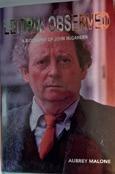



The first five entries drawn are the winners. Deadline
of entries is 20th May 2024
1 Mixture of milk & eggs for desserts (7)
5 Staff of life? (5)
8 Can mere cash buy this soft wool? (8)
12 Period of time as in school (4)
16 Unpaid sportsperson (7)
17 Unit used to determine the energy of food (7)
18 Neither Pa nor Ma wear one when cooking! (5)
19 & 65 Across. He’s celebrated on 17th March. (5,7)
20 Don’t take a gun to this African antelope! (3)
21 Juliet’s lover (5)
22 Sloping land especially by a river (4)
23 Strikingly strange, from a faraway place (6)
24 Small hard fruit such as sunflower or sesame (4)
29 Don’t pelt me in this place of worship! (6)
31 Saoirse __ or ___ Keating? (5)
32 Vacation (7)
35 & 61 Across. It’s on 31st March 2024 (6,6)
39 Added up to or came to (8)
40 French couturier who created the New Look (4)
41 French couturier & perfume creator, ___ Ricci (4)
42 Perpendicular or upright (8)
47 Larceny (5)
49 Persistent, dull pain (4)
50 Chubby or slightly fat (5)
51 Shelter serving as place of safety (5)
52 There are 366 days this ___ (4)
56 Vale in County Wicklow (5)
59 Chef ___ Allen or Du Maurier’s ‘My Cousin ___’ (6)
60 Canvas shoe or plimsole (7)
61 See 35 Across
64 Flow freely and abundantly (6)
65 See 19 Across
67 Rounded stone found on a beach (6)
69 Comedy characterised by broad satire (5)
74 Irish author of ‘Dracula’, ___ Stoker (4)
75 One who gives (5)
76 Female fox (5)
77 Very tight (4)
78 Unlimited expanse .. empty area (5)
83 Lifting device, moves people from floor to floor (8)
84 Simnel ___ often associated with 35 Down (4)
85 Periods marked by distinctive character (4)
86 Change downward or lessen (8)
89 Two-storey apartment (6)
91 Smooth board used by artists to mix colours (7)
92 Fresher - less old (5)
93 Recess or cupboard used for storage (6)
97 It’s a pure South American republic! (4)
98 Katie Taylor’s sport (6)
100 Emit a steady light (4)
101 Greedy king with golden touch (5)
102 Residue remaining after burning (3)
108 Rear part of ship or quite austere (5)
109 Garment worn around the neck for warmth (5)
110 I rushed to rear this Indian-born novelist! (7)
111 Massive tidal wave (7)
112 Fee levied for use of roads (4)
113 Graveyard (8)
114 Out of practice .. brownish-red (5)
115 Tall tower on a church (7)

DOWN
1 Pack in to capacity (4)
2 Monarchy on the Iberian peninsula (5)
3 Highest point of something (4)
4 King of Leinster 1127-1171, ___ MacMurrough (6)
5 Unmarried male (8)
6 ‘First Lady of Song’, ___ Fitzgerald (4)
7 Could I adorn Oscar Wilde’s Mr Gray? (6)
8 Impudence or one under each eye? (5)
9 Village & castle in the Boyne valley (5)
10 Can a major mar this aromatic herb? (8)
11 Impressionist painter, Pierre Auguste ___ (6)
13 Apparent, obvious (7)
14 Principal bullfighter who kills the bull (7)
15 Sure-footed, hardy equine (3)
25 Ocean on the Wild ___ Way (8)
26 Celestial body such as Mercury or Venus (6)
27 I also like this midland county (5)
28 Open pastries with filling of fruit or custard (5)
30 Thomas ___, wrote ‘The Last Rose of Summer’ (5)
33 Semisolid unction or salve, used as a remedy (8)
34 Scottish island off the Ross of Mull (4)
36 Creator of espionage novels, John ___ (2,5)
37 Irish thoroughbred, known to sparkle? (5)
38 At no time in the past or future .. (5)
43 Popular hard, smooth-textured cheese (7)
44 Large truck designed to carry heavy loads (5)
45 Elegance or stylishness found in Chicago? (4)
46 Small restaurant with a new face? (4)
48 Dressed coat of a mammal (3)
53 Town that straddles border between Armagh & Down (5)
54 Diminish gradually to a point (5)
55 Surface layer of ground (4)
57 Military ___-___ such as Baldonnel (3-4)
58 Group of islands in Galway Bay (4)
62 Unfortunate mishap or collision (8)
63 Animal skin made smooth & flexible (7)
64 Fencing sword with slightly curved handle (5)
66 Absent without permission (4)
68 Troublesome child or holy terror (4)
70 Viper - can be found in wasps and raspberries (3)
71 It comes before twelfth (8)
72 Who were Beckett’s characters waiting for? (5)
73 Precious gem or stone (5)
78 Saunter or walk leisurely (6)
79 See 100 Down (5)
80 Gentleman’s gentleman (5)
81 Undulation or fluctuation (4)
82
Dublin hospital, ___ Misericordiae (5)
87 Soak food in a mixture of oil & spices (8)
88 Industrial plant for purifying crude substance (8)
89 Lodge money in an account (7)
90 Nationalist leader or Dublin square & street (7)
94 Rich, creamy dessert often with chocolate (6)
95 One who uses a divining rod to find water (6)
96 Prickly, succulent plant (6)
99 Socially awkward act or faux pas (5)
100 & 79 Down. President of Sinn Fein 1983-2018 (5)
103 Small adhesive token stuck on letter for posting (5)
104
Smallest whole number (3)
105 Lyric poems found in modest episodes? (4)
106 Irish nationalist & Nobel Peace Laureate, John ___ (4)
107 Having discernment & wisdom (4)
Connie McEvoy makes a special cane-work Tray
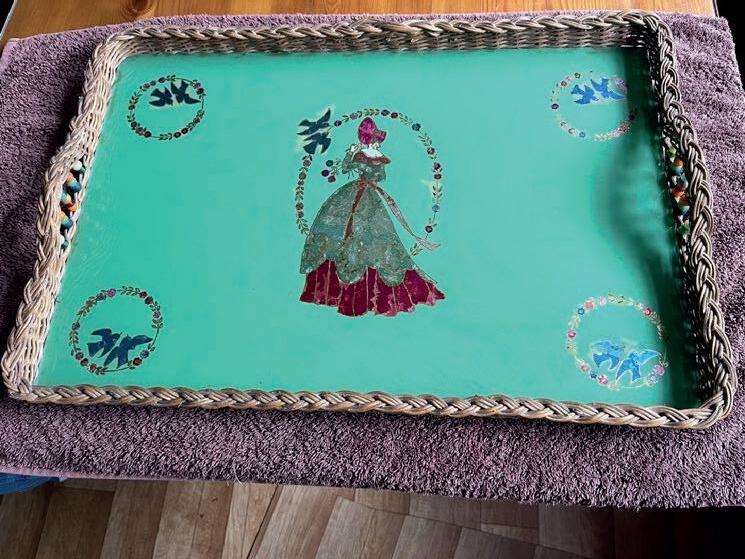
bustle.
I can remember ration books in households and seeing the workman on our farm walking to the half door each Monday morning and handing Mam a batch loaf because he got his breakfast, dinner and supper/evening meal in our house, she didn’t want him to do that as she baked all of the bread needed but he felt it was his duty to contribute and would have been offended if she didn’t accept it.
Christmas was a special week for all families on Kilcarry lane in those days, however Easter didn’t seem very special in the eyes of my brother Liam and I the only children among all of the adults then, I do remember being taken to find Easter eggs in the orchard on Easter morning when I was just five years of age, we were very excited when we found those chocolate covered marshmallow eggs that were encased in the most beautiful shiny paper.
to look after while we enjoyed a great treat.
After breakfast was over the shiny papers were placed on a folded sheet and any creases were carefully flattened with a face cloth, we never knew what happened to them afterwards until the Summer of 1957 when Clonegal guild I C A invited a hand craft teacher to direct a tray making course for members who were interested in such a craft and all members joined up for the three night duration to make a small beginners tray including yours truly. As Mam had learned the craft at a Summer school in Garryvoe during 1946 she requested materials for a larger tray as she wanted to paint crinoline lady outline motifs on glass which would then be laid on the standard base. The crinoline motifs were outlined with gold paint and the rest of the glass was painted in a nice shade of green, when the art work was dry she took the beautiful shiny papers from her safe
new and thanks to my niece Juliann and her husband Lelu I can forward a photo, after a search in the attic it will be possible to forward a photo of the one I made also.
Here’s hoping all readers of Senior Times will be gifted an egg in shiny paper this Eastertide!!








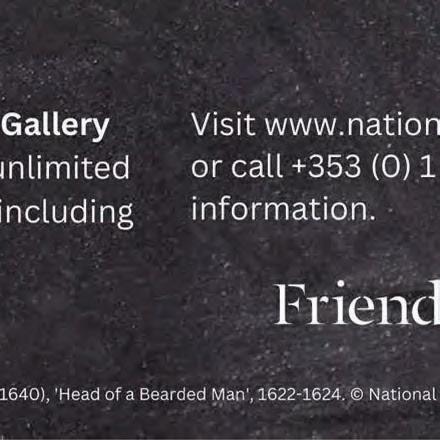



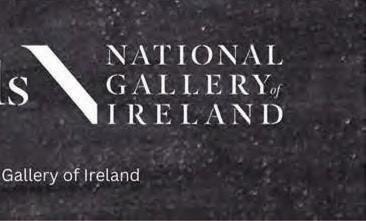






















At Doro we focus our easy to use feature phones, and smartphones, on keeping seniors connected and enjoying life! With loud and clear sound, large buttons with high contrast and an assistance button on all devices to make daily life and using technology easier. Now they come with 4G connectivity, for faster and more reliable call and text transmission, keeping you doing exactly what you want to be doing with your time.
